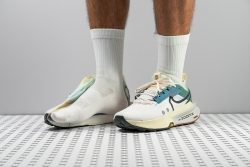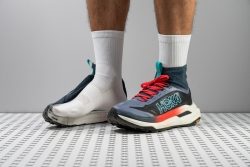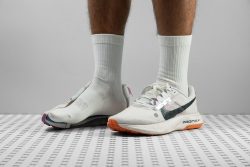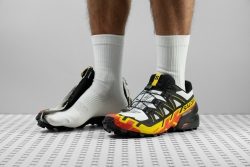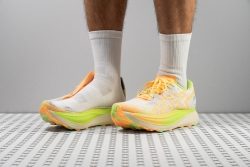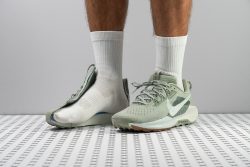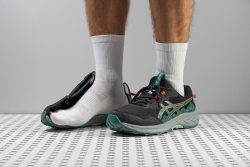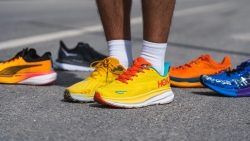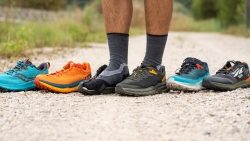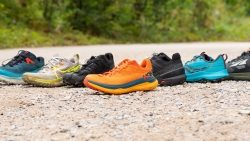7 Best Trail Running Shoes For Men in 2025
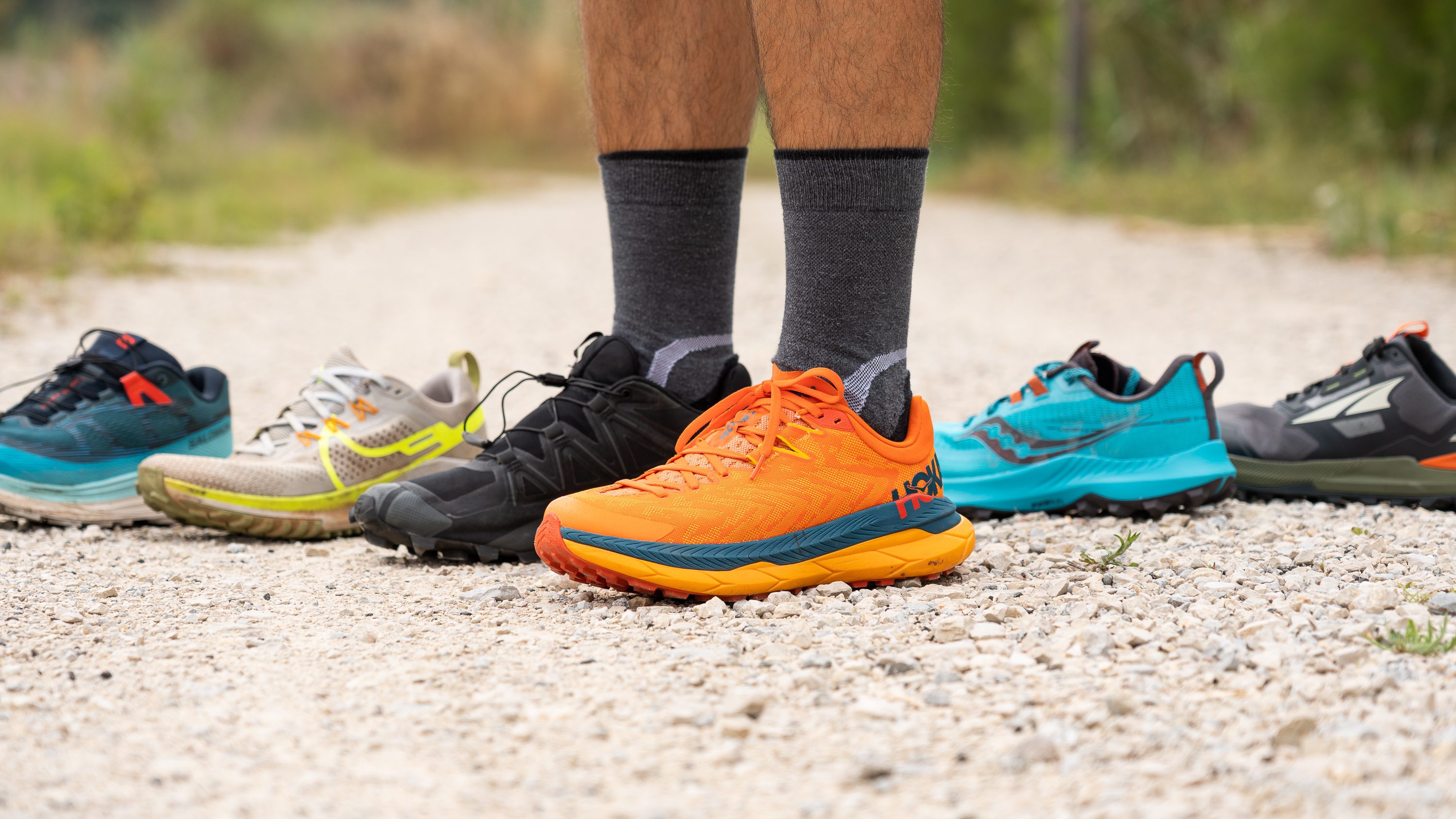
We buy shoes ourselves. We earn commissions when you buy through us, at no extra cost. Why trust us
The list of men’s trail running shoes is quite extensive and the task of finding the best one can be quite overwhelming. On the bright side, we already did the tedious work of testing men's trail running shoes so that you can learn directly from us how they fit, perform, and how durable they are.
So, if you are looking to buy some of the most outstanding trail shoes, we have made this list specifically for you. We have carefully selected the best shoes in different categories if you're in a rush. For more nerdy runners, we wrote a whole guide explaining each relevant trail shoe feature in detail.
How we test trail running shoes for men
As avid critics of running shoes, we get down to the nitty-gritty of each trail running shoe for men before we hail them as our top pick. We have even invested in our very own shoe-testing facility to examine each model more closely and accurately.
There are the steps we strictly follow to keep our choices as bias-free as possible:
- We buy each men's trail running shoe we assess with our own money.
- To see how they perform and how durable they are, we log miles in each model. We use them with versatility in mind, from light trails to technical ones, both in wet and dry conditions.
- In our lab, we cut each of them open in order to do even more tests and examine technologies used to make the shoes.
- We then measure every aspect of the shoe via multiple parameters, including energy return, shock absorption, traction, breathability, durability, flexibility, etc., which results in 20+ data points that describe each shoe.
Best trail running shoes overall
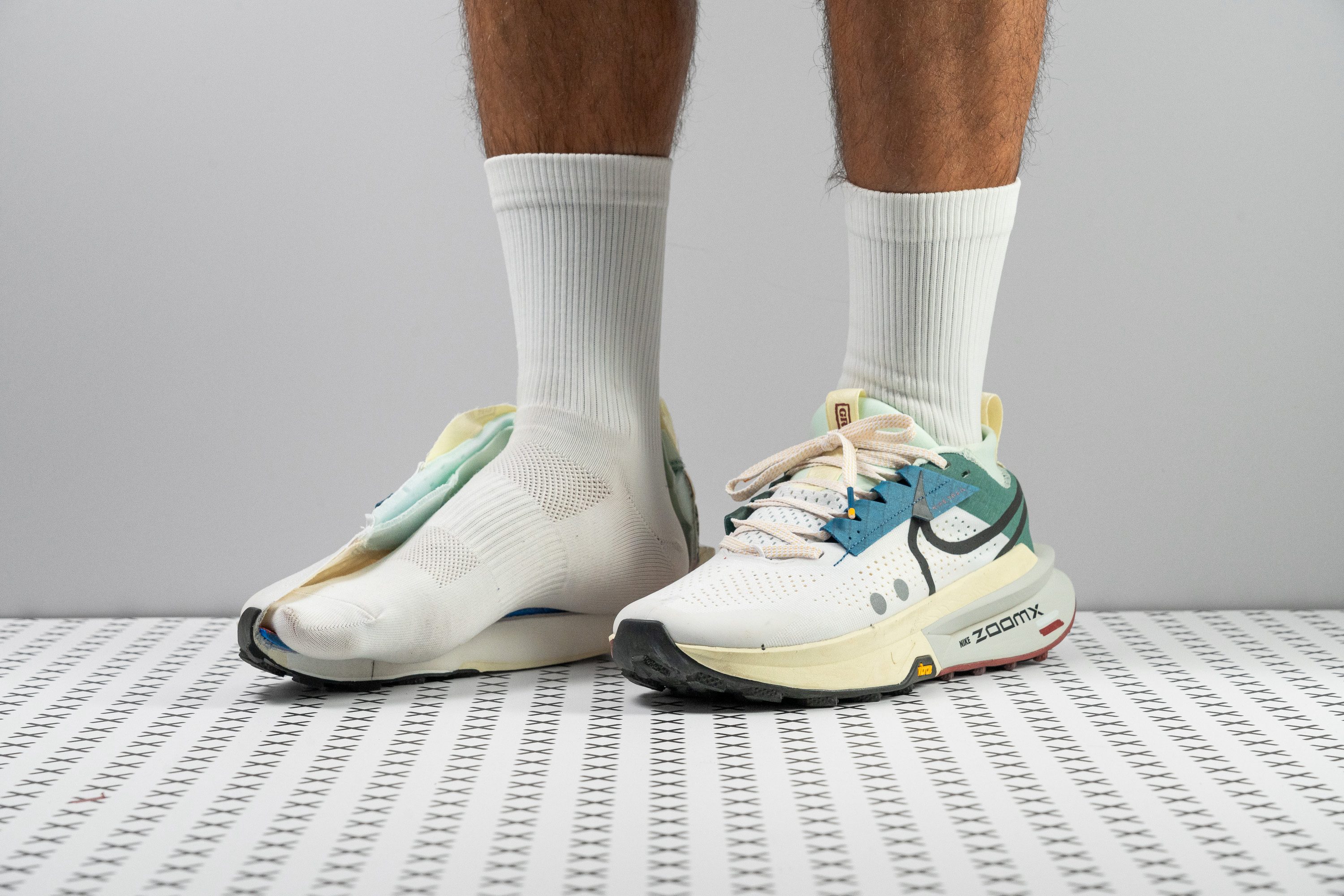

























































What makes it the best?
We explored the mountains with no sweat, figuratively and literally, as the Nike Zegama 2 offers a smooth and pleasant ride with its plush ZoomX midsole, rocker geometry, and refreshing upper. Our lab tests confirm its comfortable yet controlled ride thanks to its low drop and grippy Vibram outsole, making it our ultimate men’s trail running shoe.
The ZoomX midsole, with a stack height of 30.3/26.3 mm, measures 36.7% softer than average. These figures translated to our feet with excellent impact protection and a springy sensation. The platform features a low 4.0 mm drop, which enhances stability during downhill and unpredictable terrain.
We remain centred thanks to the Zegama 2’s rocker geometry, which suits men who prefer smooth assisted forward transitions. The outsole also features the highly reliable Vibram Megagrip rubber, which delivers a safe and well-balanced ride. It includes deep 4.0 mm lugs that keep us steady on wet or dry, loose or compact ground.
Meanwhile, the upper delivered surprising ventilation since trail shoes tend to run warm. Smoke passed through the upper easily, so we rated it with a 4/5 breathability score. We had zero instances of our body heat building up.
However, men seeking a weightless and agile feel will be disappointed with the Zegama 2. Its 10.7 oz (302g) build will be a drag on the feet.
Pros
- More ZoomX bouncy foam!
- Vibram Megagrip outsole
- Spacious upper
- Exceptional durability
- Superb wet condition traction
- Ideal for midfoot and forefoot strikers
- Ready for long-distance running
- Suitable for hiking too
Cons
- Could be lighter
- Not ideal for heel strikers
- Limited toebox vertical space
Men's trail running shoes with the best energy return
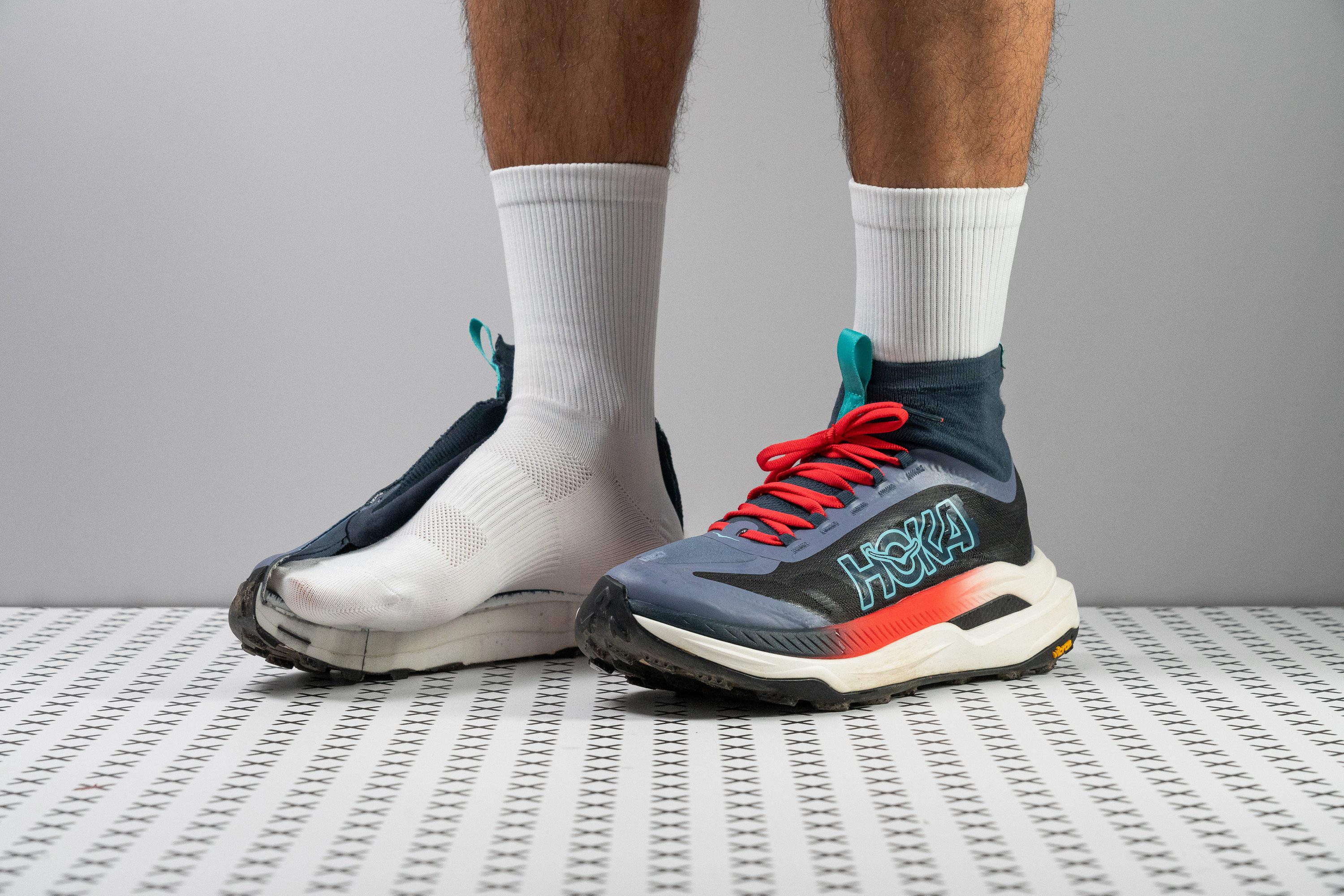


















































What makes it the best?
After our outdoor runs, we believe men seeking the most energetic trail running shoe perfectly match the HOKA Tecton X 3. It offers a snappy and grippy performance on various terrains, while providing maximum protection in a lightweight package, as confirmed by our lab results.
Tecton X 3 blends propulsion and impact protection in its generous cushioning. Its 37.8/30.9 mm stack rises above average, with impressive shock absorption ratings of 139/120 SA. Every springy takeoff is taken care of by the high energy return we measured: 69.9% in the heel and 70.2% in the forefoot, ensuring zero dull moments in our runs!
Its stiff parallel dual-plate provides push-off efficiency, allowing us to consistently show top speed on any distance and terrain. Our flex test in the lab confirms it’s 30.3% stiffer than average.
It boasts a 9.7 oz (275g) build, 4.8% lighter than the average trail shoe. It’s almost as light as a road-running shoe but holds the traction of a trail shoe. With lugs 4.0 mm deep, it clings to almost any type of terrain. We can easily manoeuvre the shoe on loose dirt and muddy puddles. The Vibram rubber also serves as our shield underfoot, as it shows impressive wear resistance in our Dremel test.
Sadly, some of us had a hard time trying to get the fit of the high ankle gaiter right. Men who find this a hassle should try another shoe.
Pros
- A true supershoe for trails
- Ultra-grippy and durable Vibram outsole
- Fantastic energy return from PEBA foam
- Versatile for both long runs and ultra races
- Stability improvements
- Shields from debris effectively
- Premium MATRYX upper
- Designed to dominate ultra-distance events
- Secure fit
Cons
- Sky-high price tag
- Heavier than the Tecton X 2
- Absolutely not for wide feet
- New ankle gaiter may not work for everyone
Best trail running shoes for racing
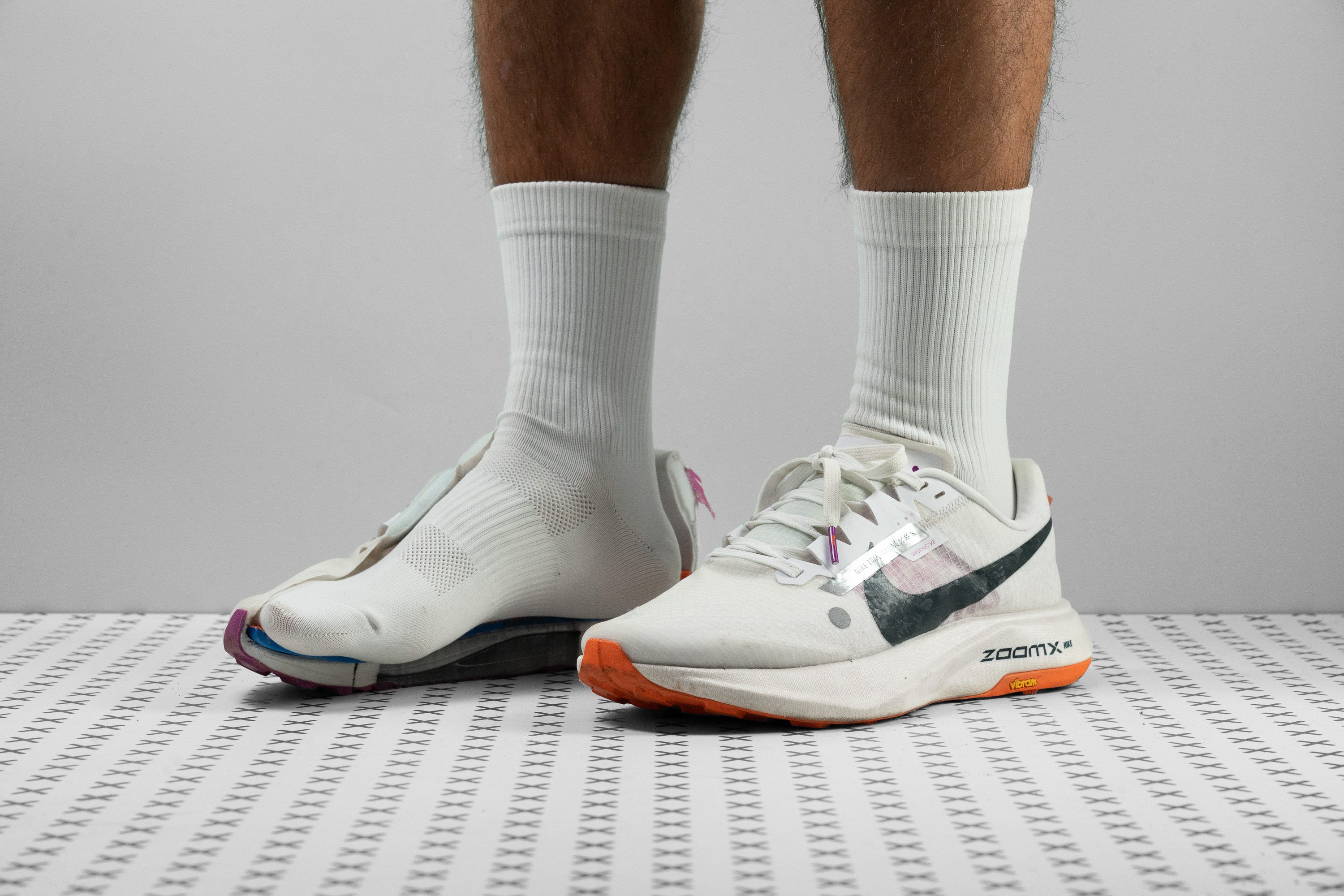



















































What makes it the best?
We found the Nike Ultrafly to be a Vaporfly for the trails with its unmatched energy return, undeniable comfort, and reliable traction in our runs. Our lab tests confirm its snappy ride through its carbon plate and wide midsole, which is why we think it’s a perfect match for men seeking a thrilling race shoe for the trails.
Our calliper reveals the platform is a thick 36.6/24.8 mm, offering effective impact protection for countless miles. The ZoomX midsole offers a cloud-like yet highly responsive sensation, which our durometer validates with a low 9.8 HA reading. Ultrafly satisfies men’s cravings for an adrenaline-filled run.
The midfoot features a forked carbon plate, which serves to both energise and stabilise the ride. It felt more natural to run at full speed in this shoe, and we had no worries because its wide 122.1/93.4 mm base kept us surefooted on various terrains. It has a high level of torsional rigidity (5/5) that makes it impossible to twist our ankles.
In addition to its stable ride, the Vibram outsole’s traction enhanced our control. With shallow 3.0 mm lugs, it felt easy to speed up because it doesn’t feel too bulky underneath. However, we don’t think its lugs are aggressive enough for challenging and muddy terrain. Men who frequent these types of trails should find another option.
Pros
- Optimised for trail races
- Accommodates wide feet with ease
- Full-length, responsive Pebax midsole
- Equipped with a Vibram Megagrip outsole
- Ideal for heel strikers
- Offers outstanding comfort
- Remarkably stable
- Suitable for 100-mile races
Cons
- The Vaporweave upper could be more durable and breathable
- Heavier than expected even for a trail racing shoe
- The $260 price tag might be steep for some
- Limited toebox height
Best trail running shoes for technical terrain
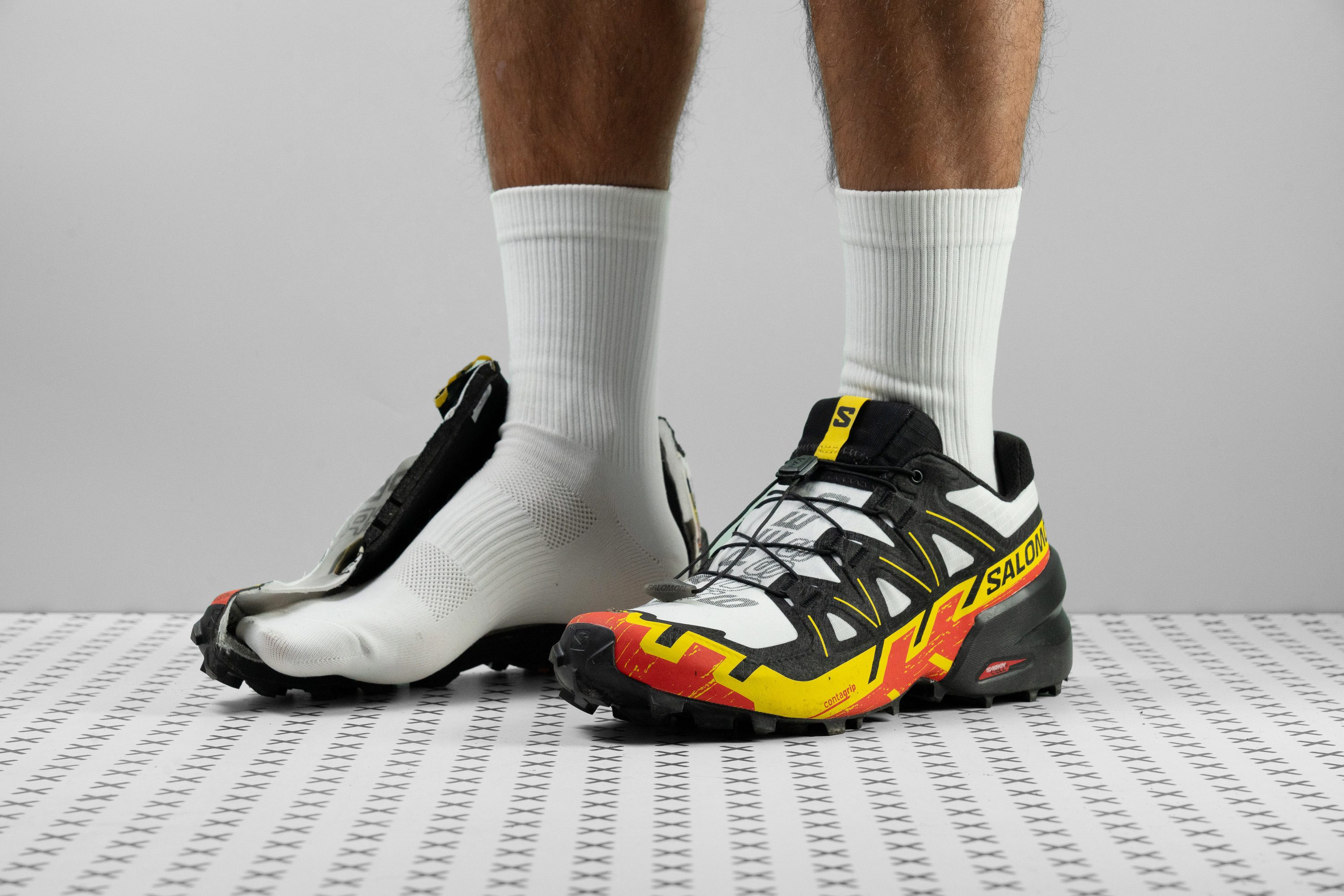



















































What makes it the best?
The Salomon Speedcross 6 has such a slim and streamlined build that got us speeding through twisty trails. It has an exceptionally stable ride thanks to its outsole, while our lab results show it has a highly protective and grippy outsole. With its remarkable blend of agility and safety, it’s our top men’s trail running shoe for technical terrain.
Speedcross 6 features a narrow 104.9/87.3 mm midsole that gives us a nimble feel as we speed through corners. At 10.4 oz (296g), it’s light for the support it offers and will fit men who prioritise agility.
To offset any imbalances and spillovers due to its slim profile, the cushion is firm and protective. Our durometer shows it’s 49.8% firmer than average, stabilising the ride. In addition, the insole has a curved shape so that we sit inside it and it embraces our foot in place.
Another safety net below us is the tough Contagrip rubber, which received a very high 93.9 HC durometer reading. In addition, the lugs are a massive 5.8 mm, 2.3 mm deeper than average, serving as extra protection underfoot. They’re designed to handle muddy conditions with ease.
However, Speedcross 6 has limited toebox height. We recommend men with high-volume feet to check alternatives so they won’t bump into the toebox uncomfortably.
Pros
- Ideal for heel strikers
- Impressive durability
- Quick mud shedding ability
- Lightest Speedcross yet
- Secure lockdown with QuickLace system
- Enhanced ground feel in the forefoot
- Agile and responsive in fast corners
- Agile and responsive in fast corners
Cons
- Midsole feels like concrete
- Extremely poor breathability
- Not suitable for midfoot and forefoot strikers
- Low energy return
Men's trail running shoes with the best shock absorption
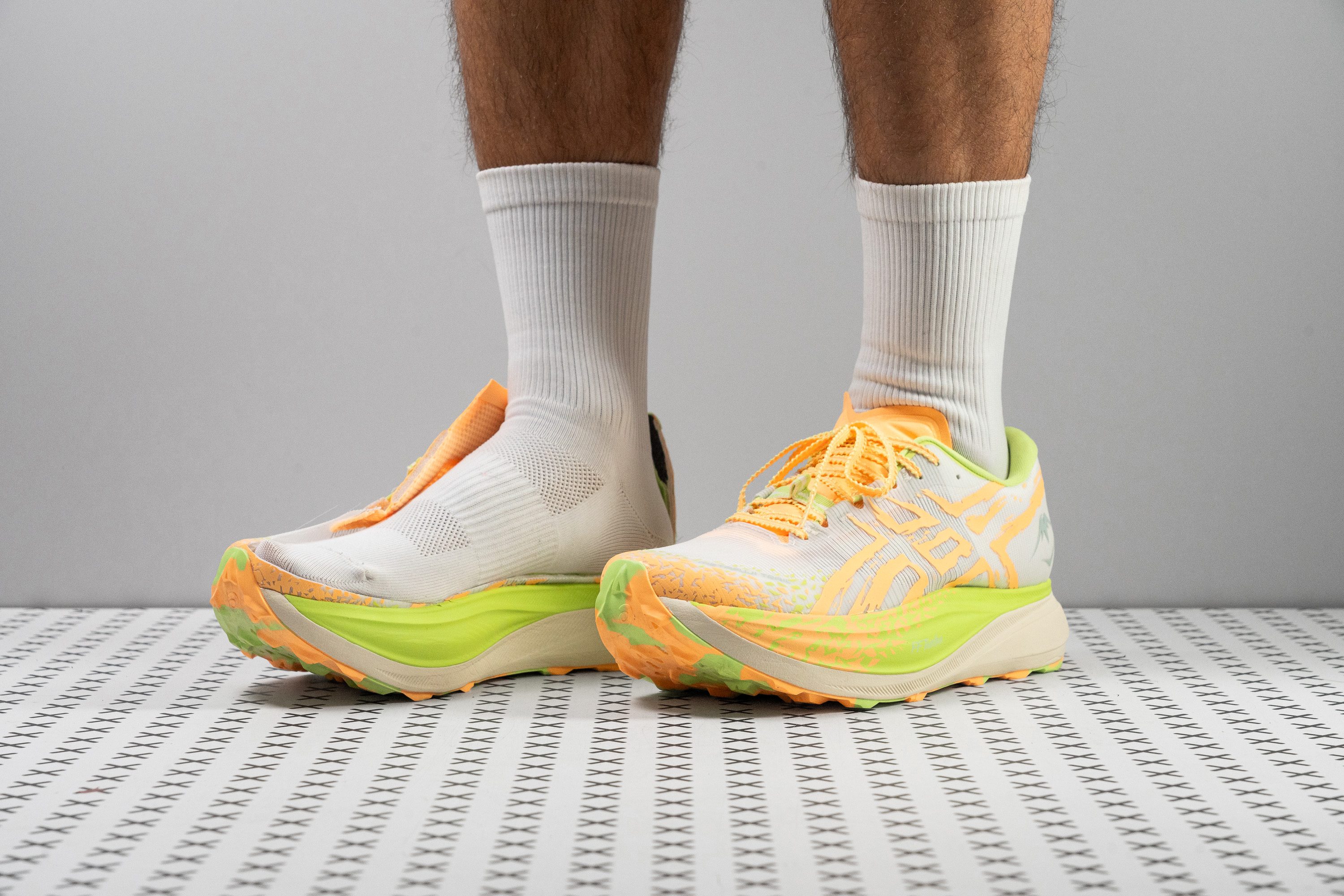
















































What makes it the best?
The ASICS Metafuji Trail offers more protection, more energy, and more traction, with its effortless sensation making the miles melt away during our mountain runs. Our lab tests prove its cushioned platform keeps our legs fresh, making it our best shock-absorbing men's trail running shoe.
Testing the Metafuji outdoors was pure bliss, because each stride felt highly cushioned and protected from impact. We measured a huge chunk of foam, elevating our feet off the ground. At 44.7/34.4 mm, we couldn’t feel anything underneath. Measuring shock absorption, the cushion impressed with a massive 153 SA in the heel and 122 SA in the forefoot.
With every gentle landing, a springy takeoff follows, which makes the ride feel more effortless. The heel and forefoot returned above-average energy return scores of 59.7% and 65.4%, respectively, confirming the pop we enjoyed during our runs.
Underfoot, the ASICSGRIP rubber offers claw-like traction on mixed surfaces, but shines best on gravel roads and easy trails. Testing it in our wet-condition test, we recorded a massive 0.80 score vs. the 0.60 average.
Unfortunately, the toebox has a tight fit, which may cause problems for ultra runners or men with broad feet. If a roomier shoe is needed, we recommend exploring alternatives.
Pros
- Exceptional shock absorption
- Amazing ASICSGRIP outsole
- High-end build quality
- Ideal for narrow feet
- Lightweight for a trail shoe
- Fast-rolling forefoot rocker
- Ideal for easy, flat-ish ultras
- Outstanding upper with top ventilation
- Record-breaking stack height
Cons
- FF Blast+ foam limits energy return
- Expensive
- Minimal stability
- Delicate upper prone to tearing
Best road-to-trail running shoes
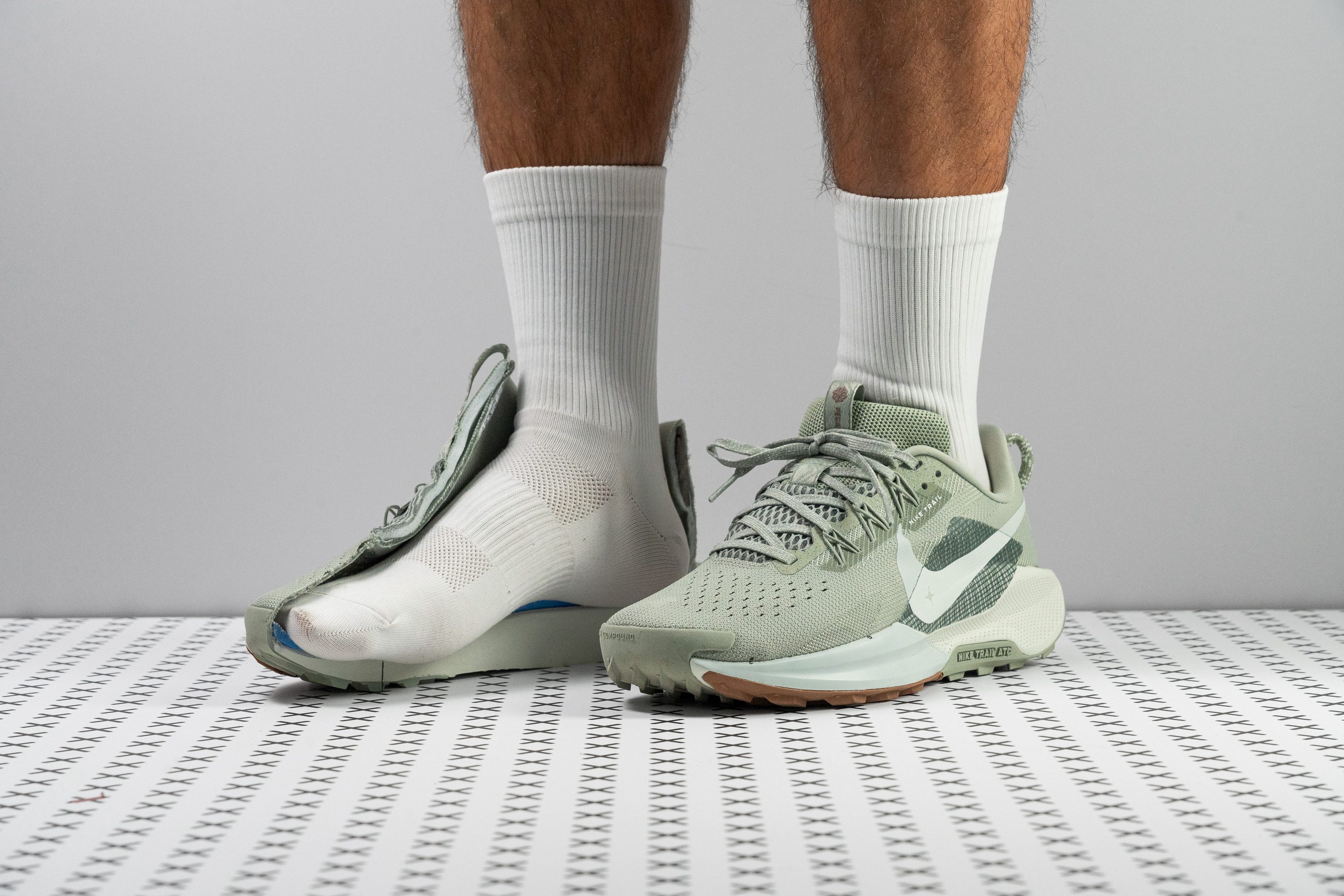






















































What makes it the best?
Intertwining the comfort and support needed for urban streets and mountains, the Nike Pegasus Trail 5 stands as our top road-to-trail shoe in the men’s trail running category. We found it to be extremely versatile with its smooth transitions, pleasant midsole, and flexible build. Plus, our lab tests and runs confirm the All-Terrain Compound outsole’s resilience on various surfaces.
The midsole promotes free and natural movement, further amplified by the strategic cutouts in the outsole. Our bend test shows it’s 29.0% more flexible than average, which explains why the shoe felt easy to manoeuvre.
The midsole kept us both energised and refreshed, offering a nice springiness while protecting our joints from landing impact. Our durometer backs us up with a reading 51.5% softer than the average, ensuring it will protect men who run long miles from the pavement to the trails.
Already in its name, the All-Terrain Compound showed solid resistance against our Dremel. Showing 0.2 mm less damage than average, it proves it won’t wear out easily regardless of the surface. It also features 3.2 mm lugs, which felt grippy on soft ground but not too intrusive when on concrete.
However, the upper delivers limited ventilation so we can’t recommend this Peg to men who seek maximum breathability.
Pros
- Fully gusseted tongue
- Reflective elements
- Durable upper construction
- New rockered sole
- Great for heel strikers
- Reasonably priced
- All-around comfort
- All-around comfort
Cons
- Weight increase
- Possibly too plush for trails
- Still lacks traction
Best budget trail running shoes
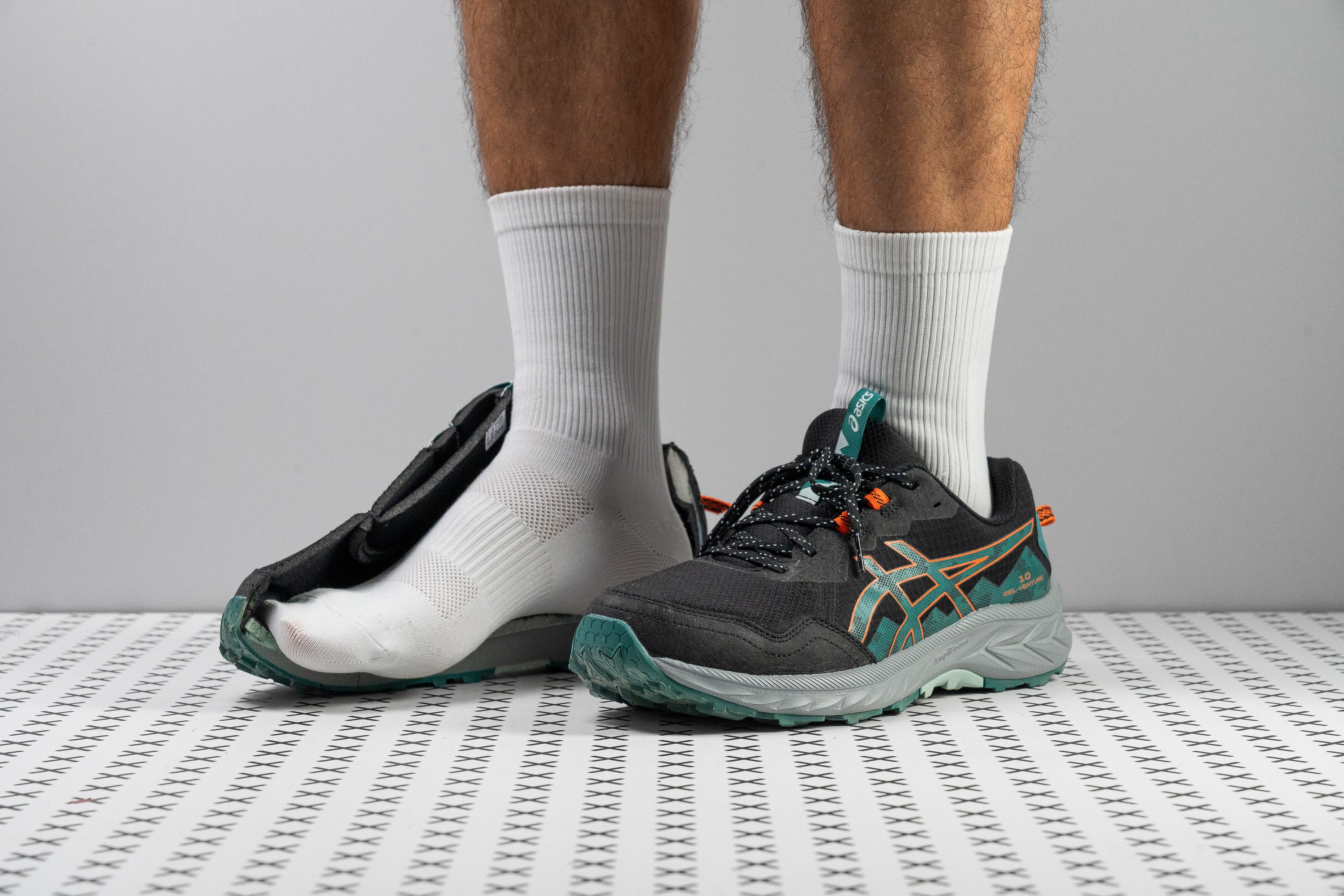











































What makes it the best?
The ASICS Gel Venture 10 is so flexible that we found it versatile for trail running and other activities. In the lab, we were surprised by the v10’s performance in our durability tests, while its lugs offer reliable traction. For only £80 vs. the £150 average trail shoe, it’s our best budget pick for men.
Comfort is amplified by the fluid midsole that bends easily with our feet. We didn’t have to fight much resistance, and our flex test agreed when it emerged 10.6% more adaptive than average. Because of this, it’s carefree enough to be used for walks and hikes.
Its versatility is further enhanced by its moderate 3.7 mm lugs, which felt subtle enough for speed runs yet effective on occasional technical sections. We also put the rubber under our mighty Dremel, and it only incurred minimal 0.6 mm damage, a solid result in the trail category.
Even in the upper and heel padding, Gel Venture 10 exceeded expectations with high durability scores of 4/5 and 5/5, respectively, cementing its hard-wearing nature.
We wondered how this shoe is priced affordably, and we found out the answer during our long runs. Men who give importance to deep cushioning should invest in another pair.
Pros
- Fantastic durability
- Amazing value
- Ideal for beginners
- Softer Amplifoam midsole
- Versatile for trail, travel, casual wear...
- Improved upper
- Plush tongue with pressure-free lacing
- Trail-inspired details at budget price
Cons
- Only for narrow feet
- Heavy
- Low shock absorption and energy return
Differences between men’s and women’s trail running shoes
There are 4 main differences: anatomical ones - women’s shoes can have narrower heels and wider toeboxes; industry labels for sizes and widths - quite different (see below); stack height and heel drop can be different in women’s shoes; colorways - often there are more pink, red, purple, etc. variants available in women’s sizes.
However, the most important thing to know when comparing women’s and men’s trail running shoes is the size conversion. This can come in handy if you have smaller feet and want to try women’s shoes. The table below shows this conversion, although there are some brands that deviate from it:
| Men's US | Women's US |
| 5 | 6.5 |
| 5.5 | 7 |
| 6 | 7.5 |
| 6.5 | 8 |
| 7 | 8.5 |
| 7.5 | 9 |
| 8 | 9.5 |
| 8.5 | 10 |
| 9 | 10.5 |
| 9.5 | 11 |
| 10 | 11.5 |
| 10.5 | 12 |
| 11 | 12.5 |
| 11.5 | 13 |
| 12 | 13.5 |
| 12.5 | 14 |
| 13 | 14.5 |
There’s no reason not to do this because, in most cases, there are no differences in shoe design when it comes to men’s and women’s shoes. Even when it comes to width, it is often about making the upper more roomy and not the base (cast) wider.
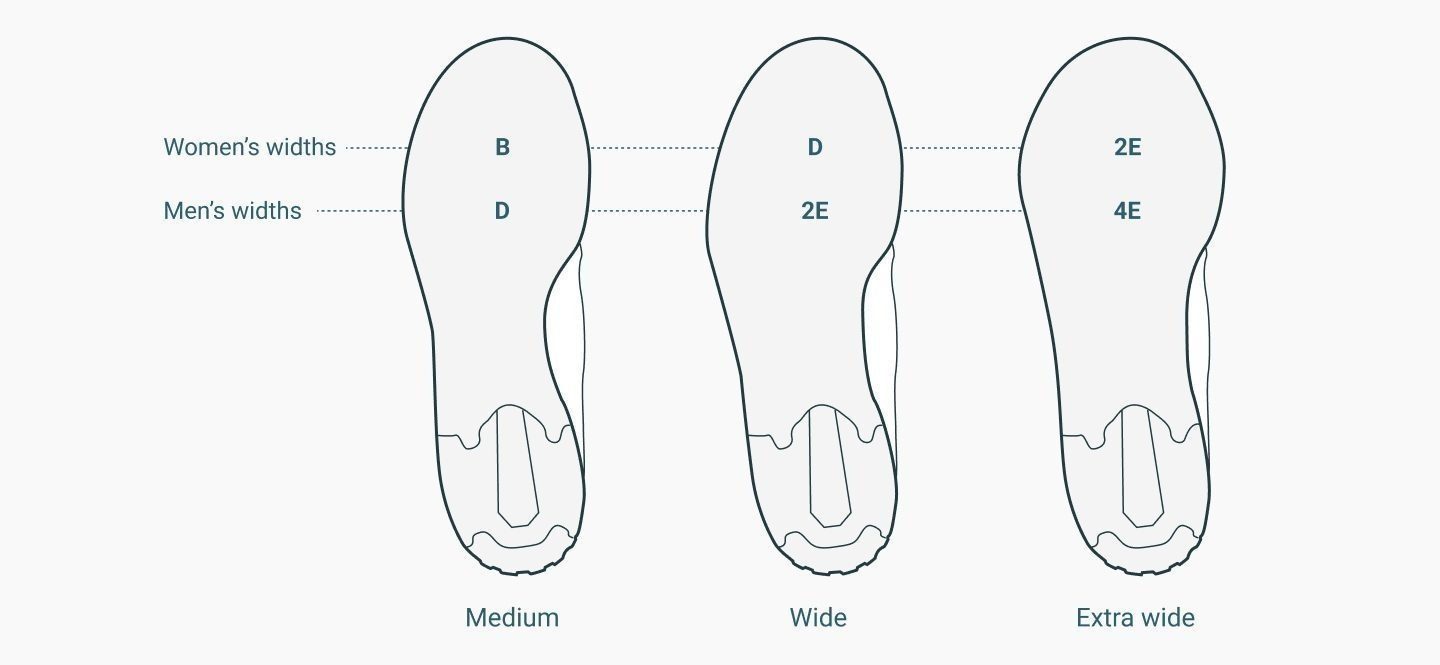
If you want to learn more about these differences, we recommend reading our guide: Understanding differences between men's and women's running shoes.
5 must-know things when buying men’s trail running shoes
There are many features of trail running shoes that we test in our lab, but these are the most important ones when looking for a new trail shoe:
- Which terrain they are made for: you’ll know this by looking at the overall design. How protective they are and how deep the lugs are
- Which season they are made for by looking at the upper! Very breathable trail running shoes have almost see-through uppers, which makes them perfect for hot weather. On the other hand, a thick upper is great in winter and a waterproof membrane works wonders in wet weather.
- Stability, especially if you’re a heavy overpronator. For this, we look at different stability features like stiff heel counters, firmer midsoles, torsional rigidity, etc.
- Shock absorption and energy return, to avoid extra stress sent to your legs and premature leg fatigue.
- Anticipated distance and pace by looking at the padding, cushioning, and overall design. Very fast trail shoes made for men who love short explosive races have a very aggressive design, low weight, and not a lot of cushioning. To be agile enough, they have to be closer to the ground. On the other hand, trail running shoes for longer distances are more cushioned (higher stack) and comfortable (more padding).
- Toebox width and height. Given the varying terrain, in trail running it’s even more important to nail the toebox volume than in road running. Otherwise, you’re risking instability, slipping, black toenails, or a strain due to sliding within the shoe, cramped toes, and overall bad lockdown.
We will cover all of these features in great detail below and add even more data-backed advice.
Terrain difficulty and how it translates to trail running shoe features
There are different types of terrains trail runners run on and some ask for very specific features. The good thing is that many trail running shoes are versatile enough so that you can use one pair of shoes for different adventures.
|
3 very broad terrain types |
|||
|
Light |
Moderate |
Technical |
|
|
Terrain examples |
Road-to-trail, urban hiking, very well-maintained trails, hard-packed flat trails |
A bit of everything, soft loose ground, occasional obstacle, rocky or a wet patch |
Mud, snow, slush, obstacles, very steep single tracks, rocks |
|
Main trail shoe features |
Not protective, shallow lugs, can be used on roads as well, usually lightweight (unless made for urban areas where style trumps light weight) |
Protection exists and varies, lugs around the average to deep, very versatile |
Very protective, very stiff, usually very deep lugs, can get quite heavy depending on the season |
The table above is very general. When finding trail running shoes, one should go even deeper and understand what trail shoes should have to keep runners’ feet safe, comfortable, and running!
The most mentioned feature here is the lug depth. In our lab, we use a digital calliper to measure the thickness of the lugs.
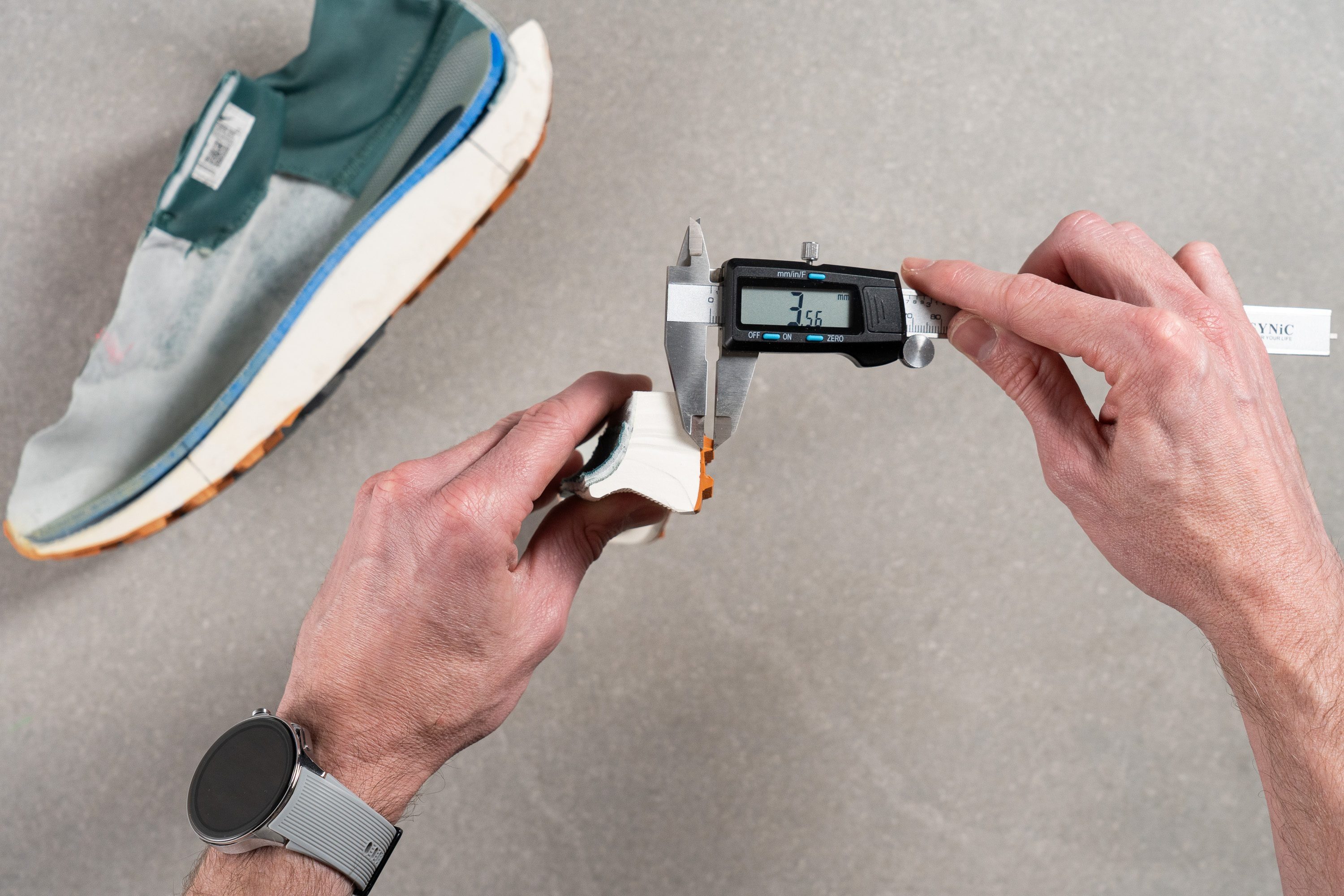
Here are a few more specific guidelines when it comes to shoe features and terrain.
Trail running shoes for mud
For running in mud, choose running shoes with very deep lugs that are spaced further apart. This is needed for mud shedding. When lugs are too close to each other, mud often just sticks to the outsole and lugs are of no value then. Depending on the season, you might want to consider a waterproof upper.
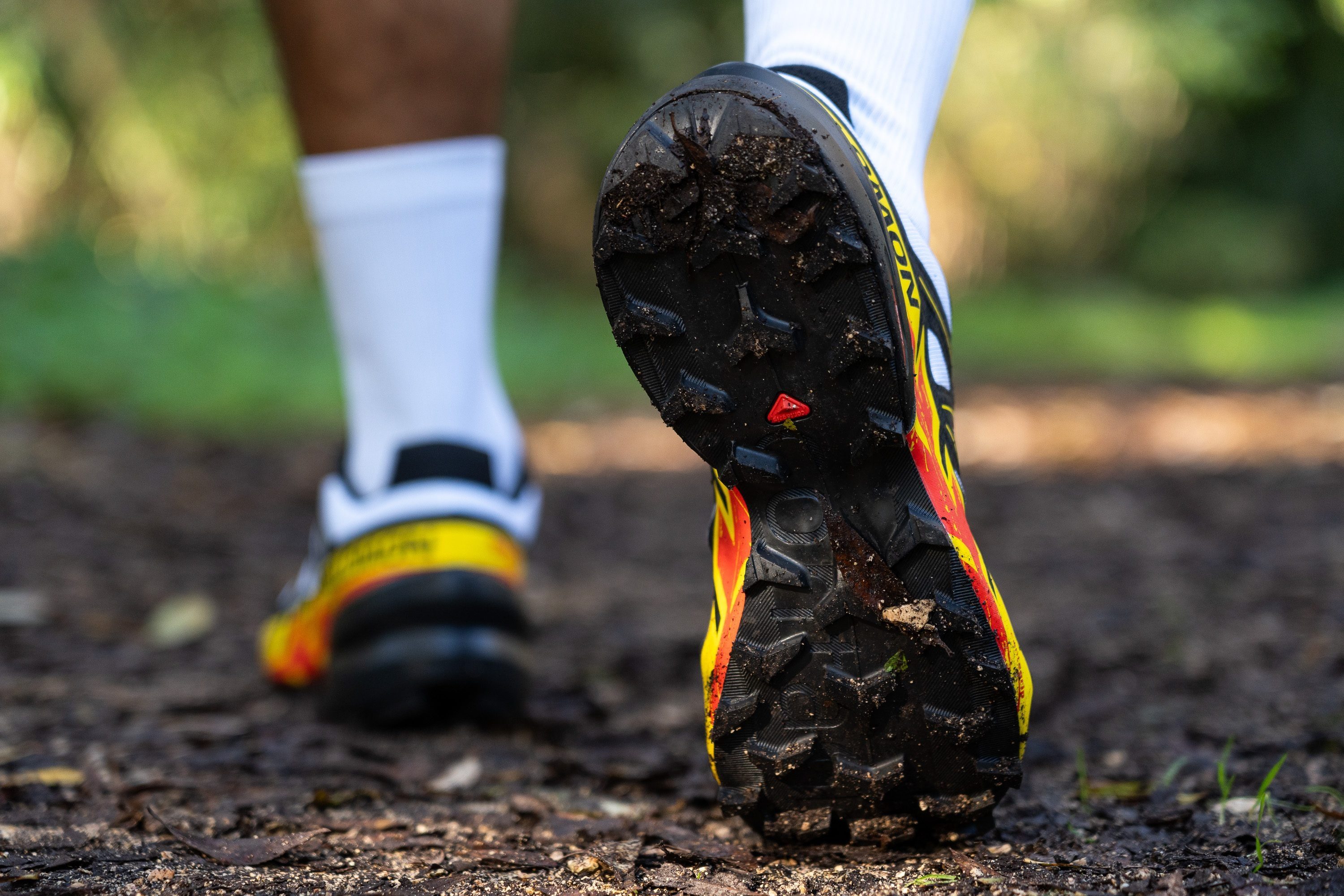
Hard-packed dry trails
For hard-packed and dry trails, it’s best to choose shallower lugs that are placed close to each other.
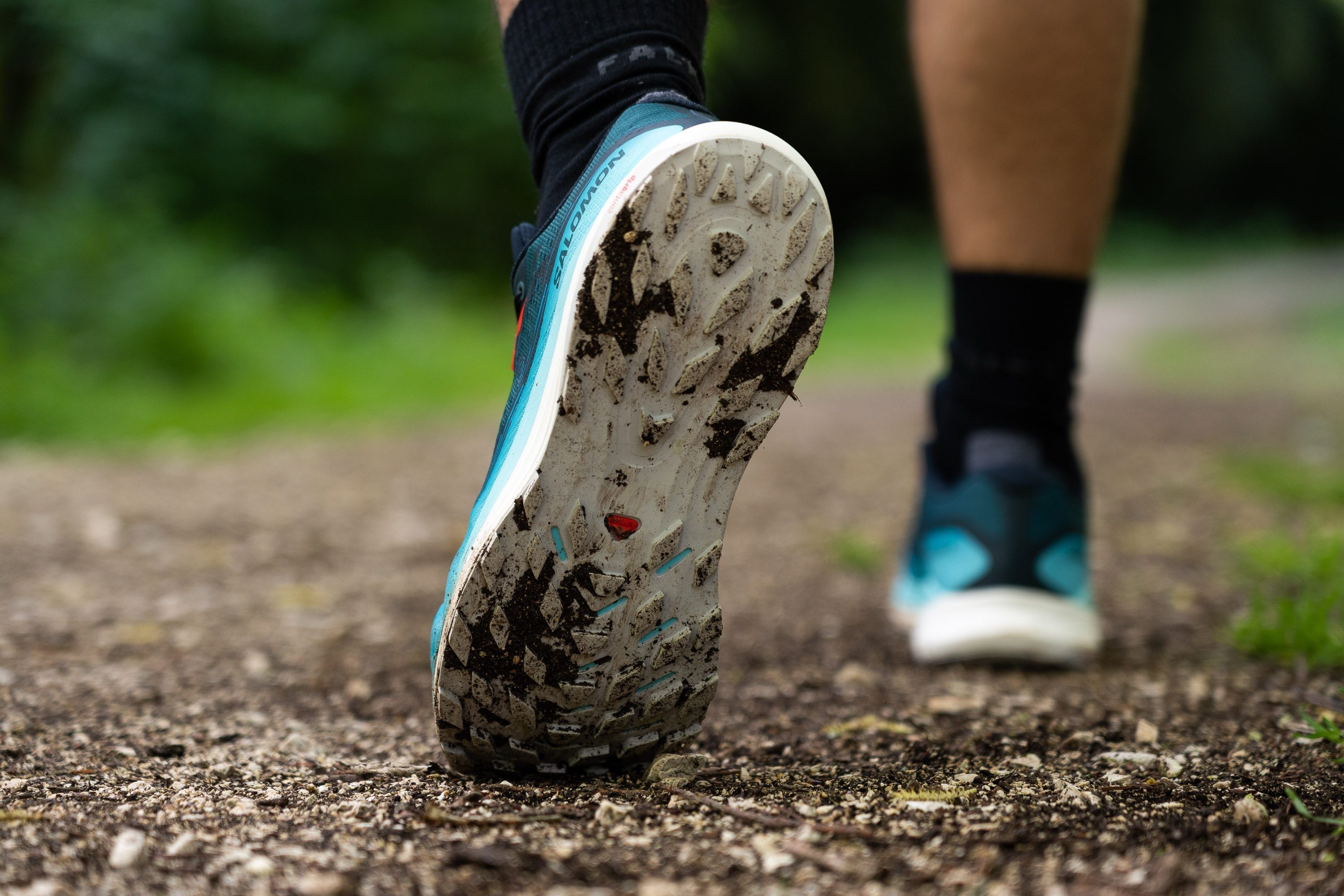
Trail shoes for flat and wet surfaces
When running over very flat and wet rocks or simply smoother surfaces, it’s best to choose shallower lugs that also have large flat lugs with a few channels in between to guide the water away from the outsole.
Sharp rocks and obstacles
If you’re running over sharp rocks or trails covered with debris and obstacles like branches and sharp vegetation, you should look for protective features like rock plates, large and thick toe bumpers, rip-stop/durable upper materials, and maybe even sock-like heel collars to prevent the debris from getting into the shoes, etc.
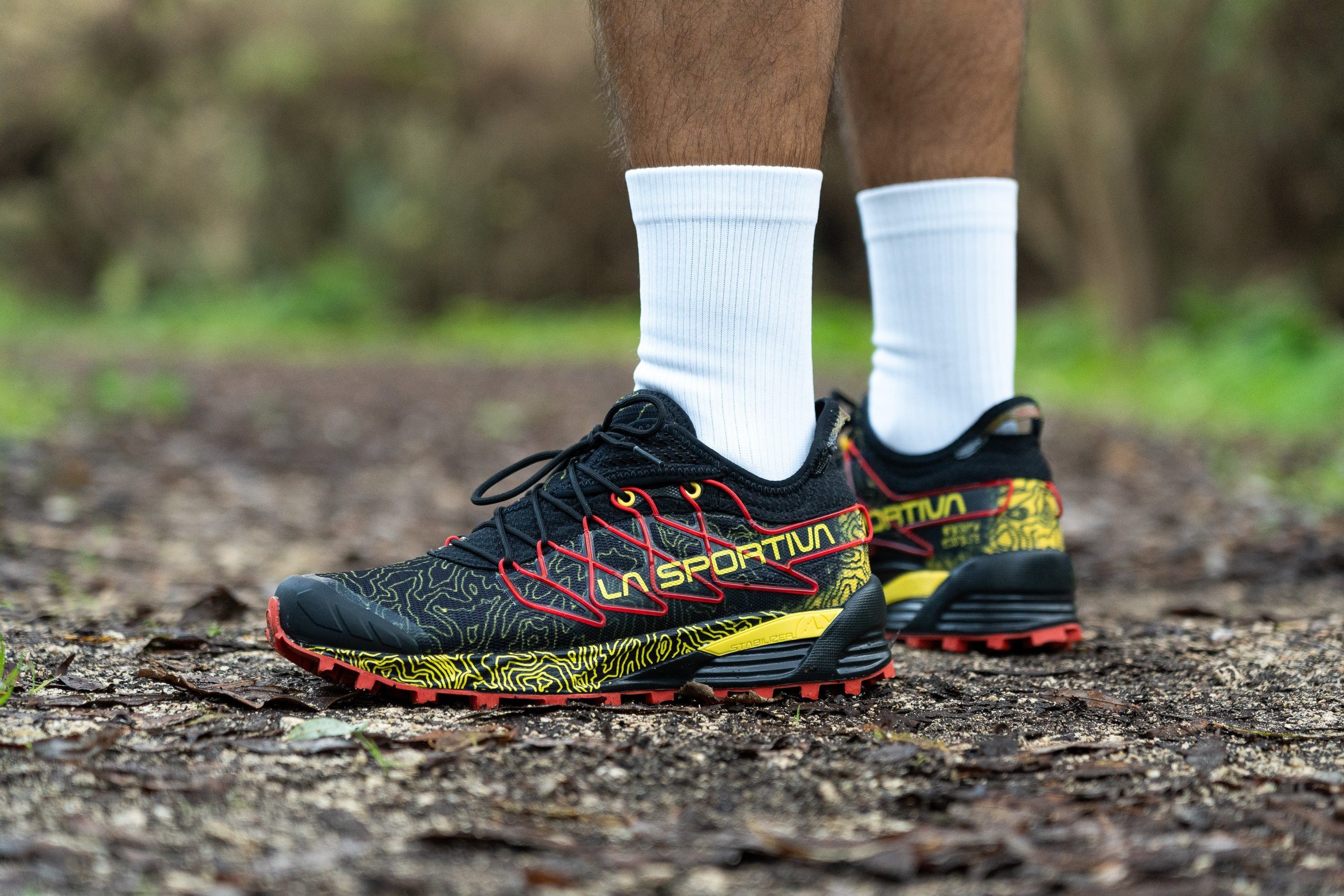
Road-to-trail running shoes
Road-to-trail running shoes or hybrid shoes have very shallow lugs because they should not hurt your feet when running on concrete, and yet the lugs still exist so that the shoes have some grip on light trail terrain.
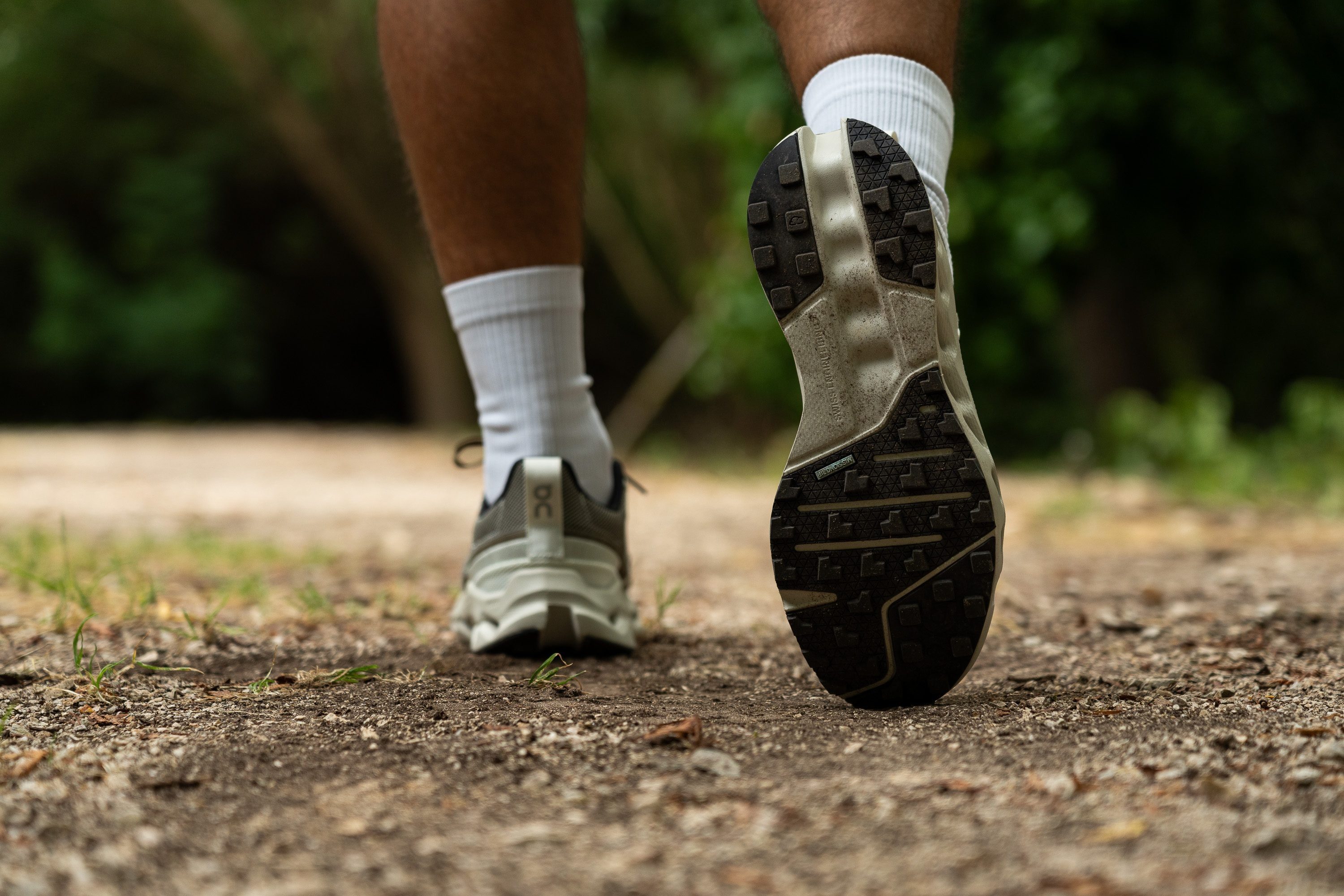
Do-it-all trail running shoes
Very versatile trail running shoes usually have multidirectional lugs of different shapes and average thickness.
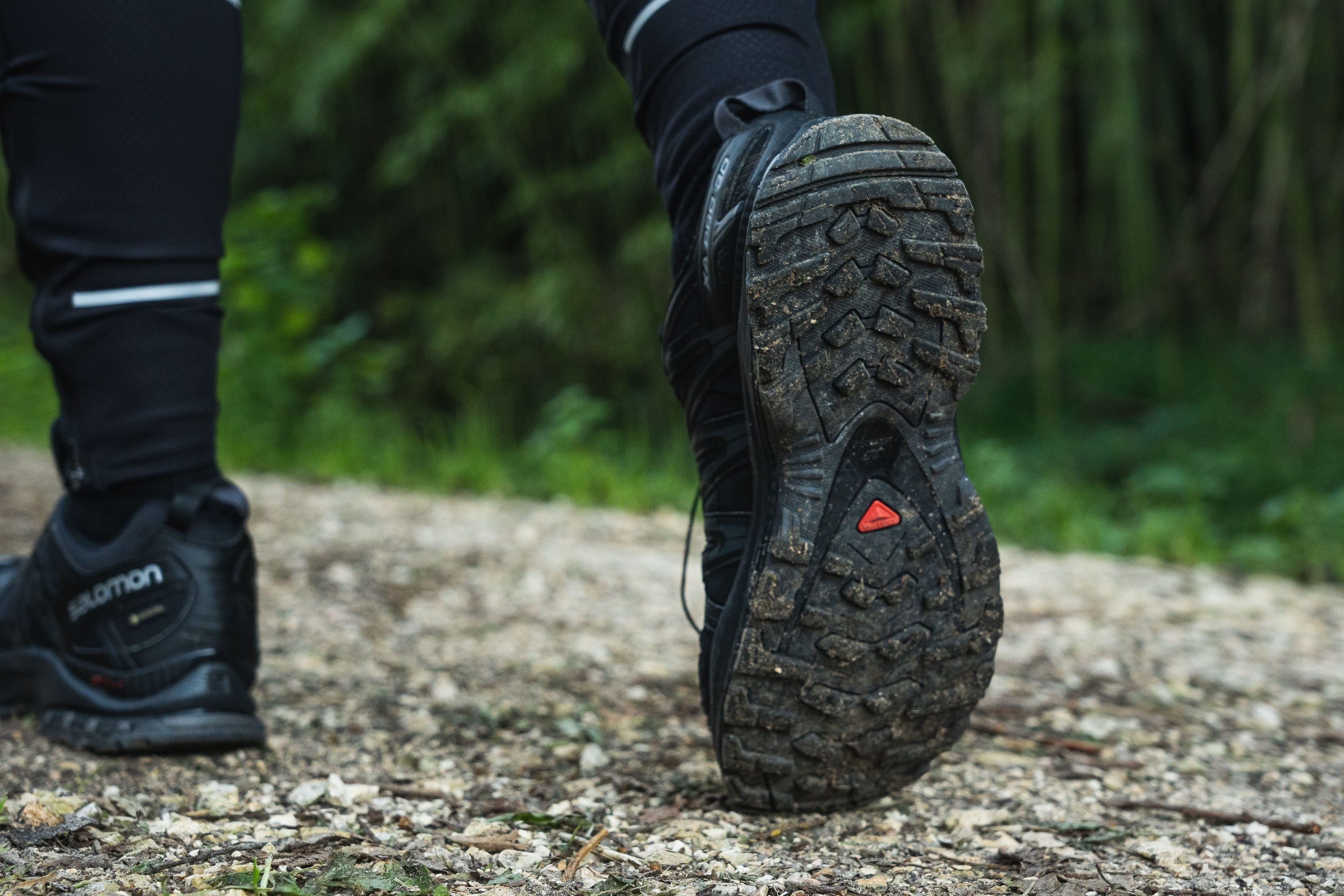
How seasons affect trail shoe choices
Now that we’ve covered the lugs and how different they are depending on the dry/wet terrain, we can also cover the uppers.
When it comes to the weather, we can look at 3 types of trail shoe uppers:
- Breathable uppers, best for hot weather when air circulation is a must,
- Non-breathable uppers or warm uppers, best for cold weather when trapped heat feels great and prevents feet from freezing,
- Waterproof uppers which keep the water on the outside.
In our shoe lab, we use a smoke machine and a 3D-printed cast that directs the smoke to test the breathability of trail running shoes
When the smoke machine is turned on, we look at the smoke and where it comes out, plus how quickly. Based on this, we rate the breathability on a 1-5 scale. Then, we look at the uppers under the microscope.
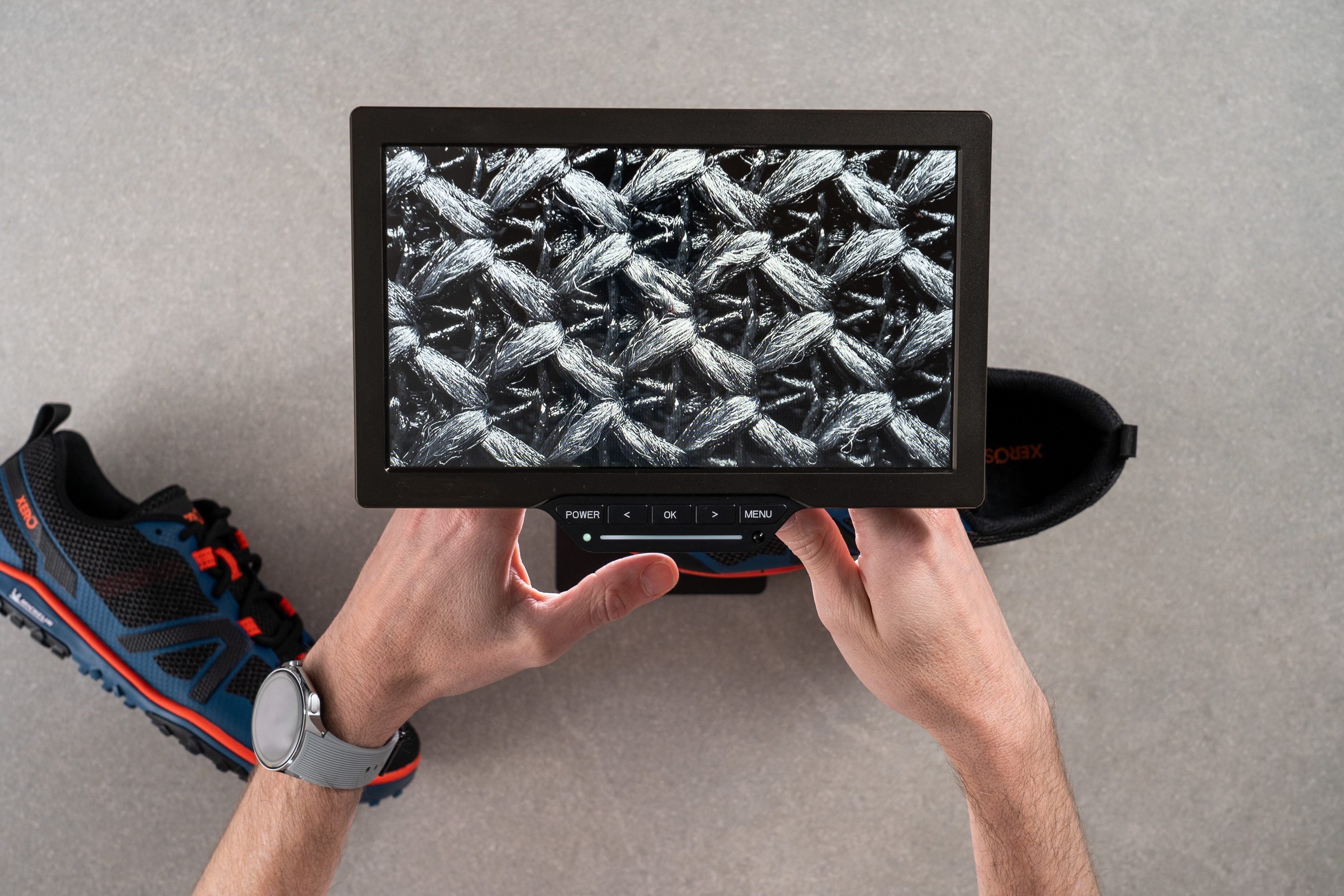
In most cases, it’s easy to understand why a certain shoe breathes well or not by looking at the images.
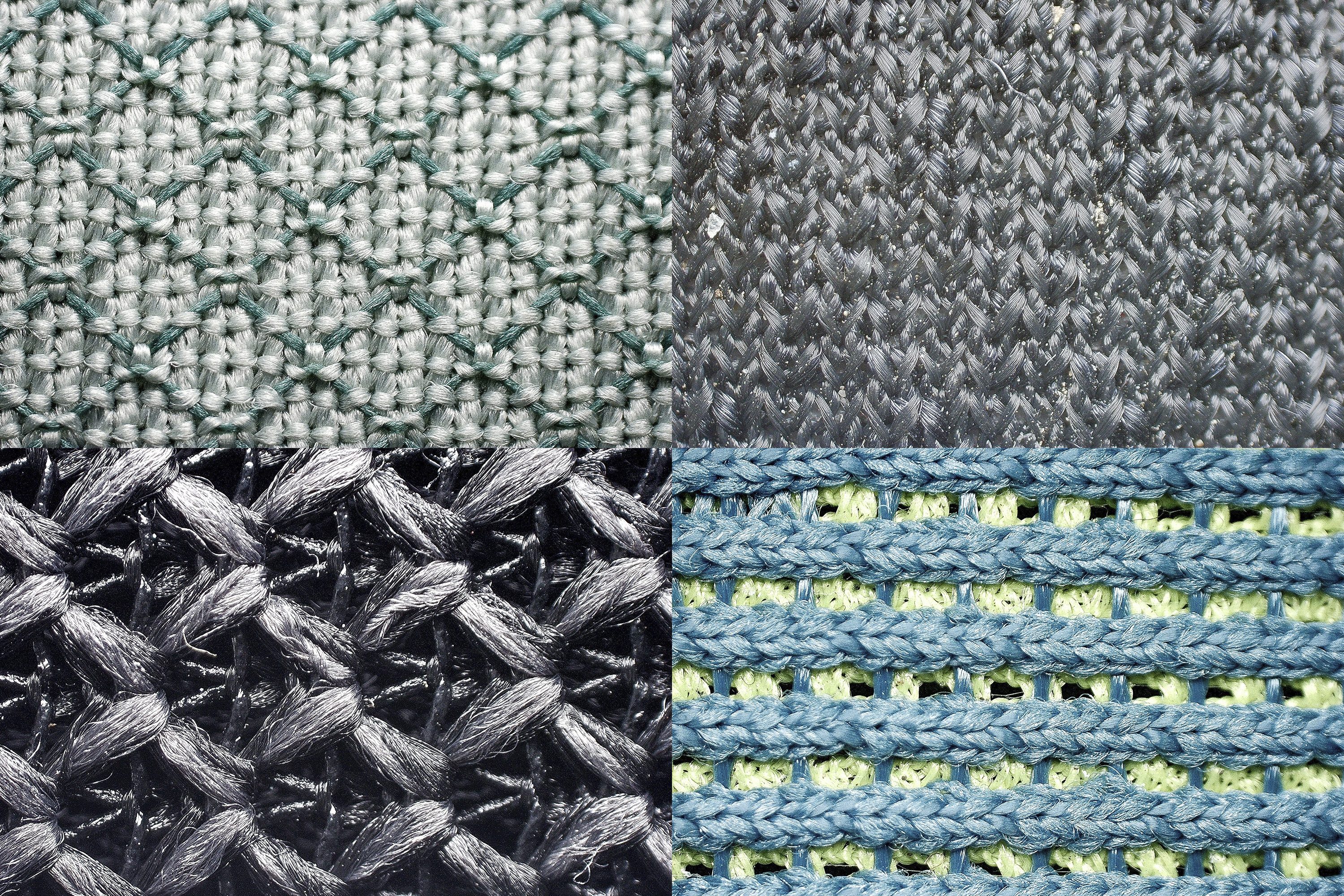
And, when it comes to waterproof trail shoes for men, they usually don’t breathe well or at all.
To learn more about waterproof membranes, how they look like, how to recognise them, and when not to use waterproof running shoes, read our guide on best waterproof running shoes.
Stability in men’s trail running shoes
Stability is mostly related to arch support. Overpronators and men with flat feet tend to wear stability running shoes. However, the terrain in trail running varies too much for stability footwear to be a big deal. That’s why there aren’t many stability shoes per se in the world of trail running. But, there are stable shoes.
Here are features we recommend looking for if you want your trail running shoes to be extra stable:
- A wide platform. The wider, the better!
- Torsionally rigid platform. This especially helps when hiking over sharp or pointy obstacles as the rigid platform keeps the feet stable so they don’t have to balance it out with a lot of small movements.
- Stiff heel counters.
When it comes to the midsole width, we have you covered! We measure both heel and forefoot platform width.
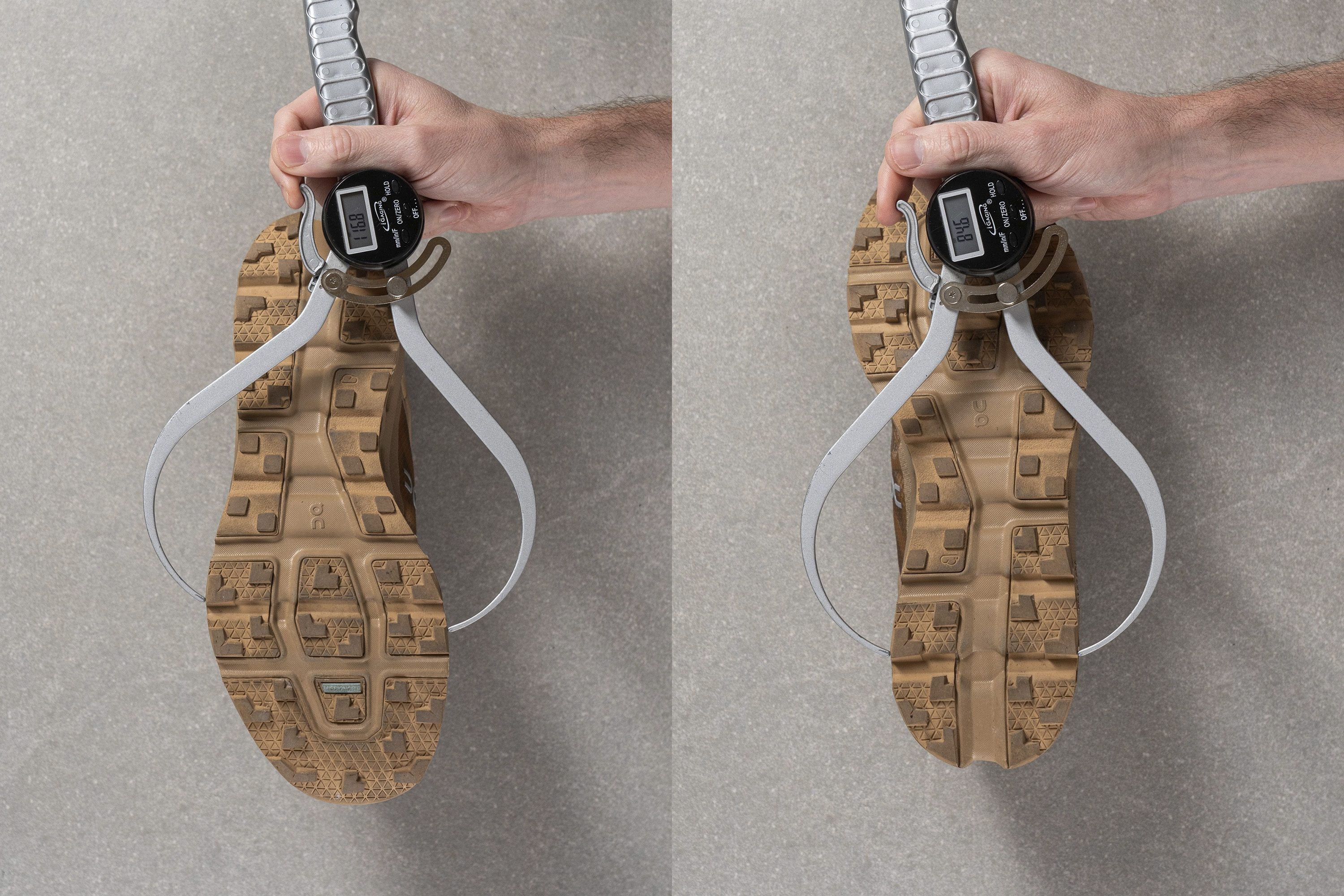
However, it is worth noting that some trail shoes can have very wide heels to the point of being bulky. This makes them unsuitable for technical terrain when you need to be fast and agile.
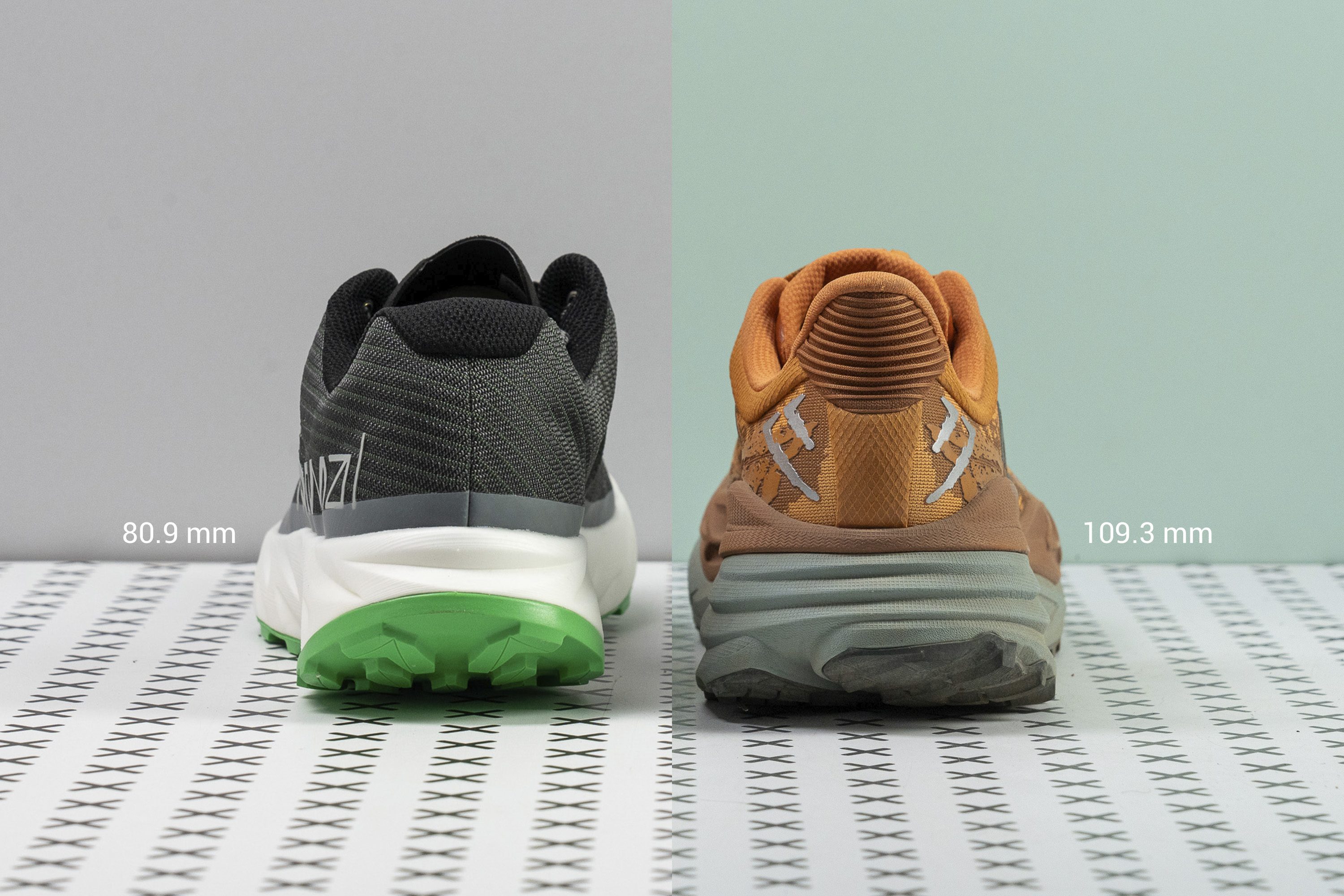
To assess the torsional rigidity, we twist the shoes in our hands. Based on how much we can twist them, we assign them a 1-5 rating, where 1 is the most flexible and 5 is the most rigid.
After finding a wide and rigid platform, we recommend you look for a stiff heel counter. In the lab, we assess the stiffness on a 1-5 scale, where 5 is the stiffest. This is quite easy to assess as we just squeeze and push the heel counter and we recommend you do it as well if buying the trail running shoes in person.
Cushioning and ground feel in men’s trail running shoes
Cushioning and ground feel are all about 2 measurements: stack height and midsole softness. Some runners prefer being low to the ground and feeling most of the bumps, rocks, etc., while others enjoy maximal impact protection and feeling nothing but the foam.
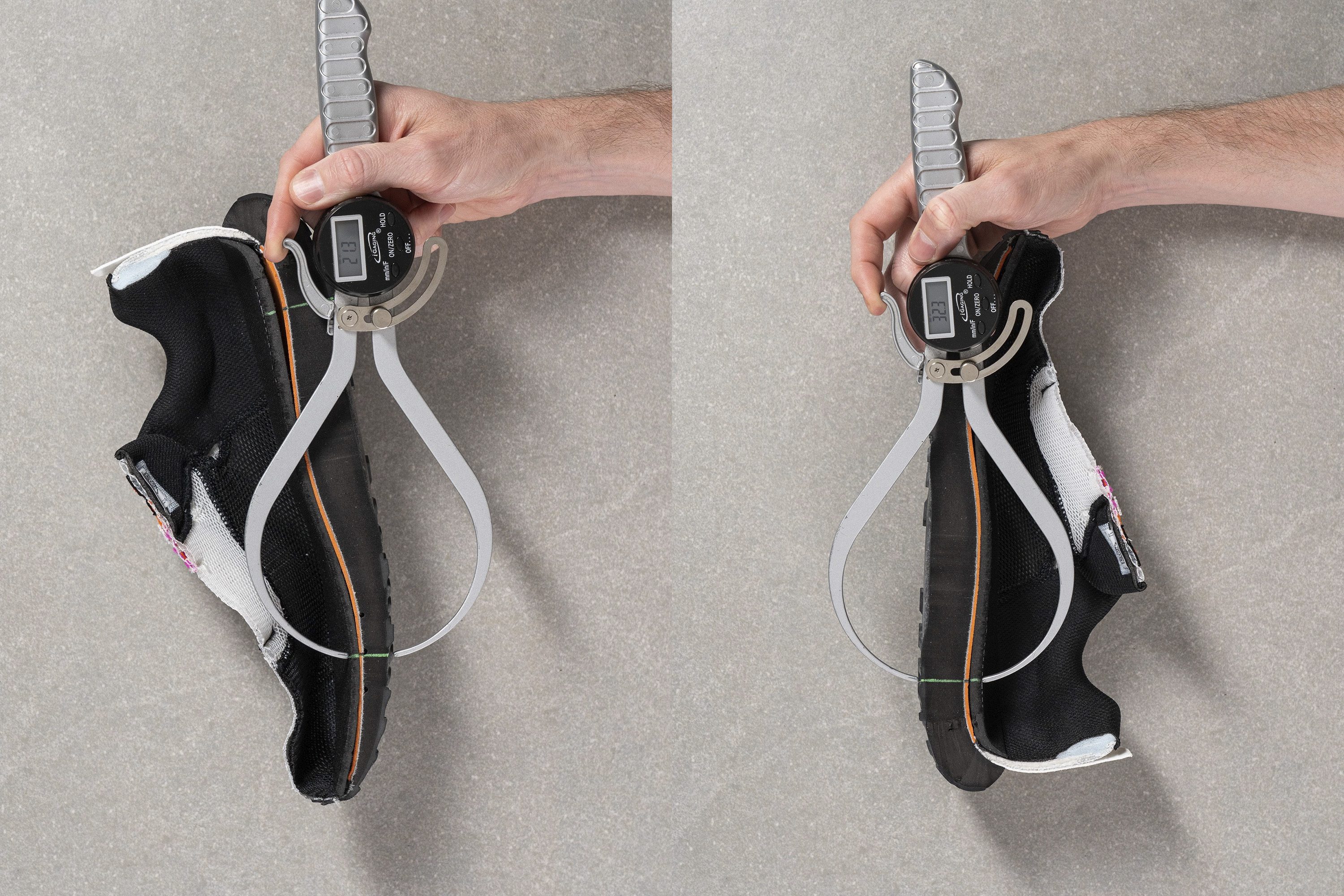
If you’re a beginner, we don’t recommend minimalist or barefoot trail running shoes. They ask for a long adaptation period and starting with cushioned trail running shoes (at least 25 mm at the heel) is a good way to go!
If you’re a fan of soft trail running shoes, you should look for those that scored low on the durometer.
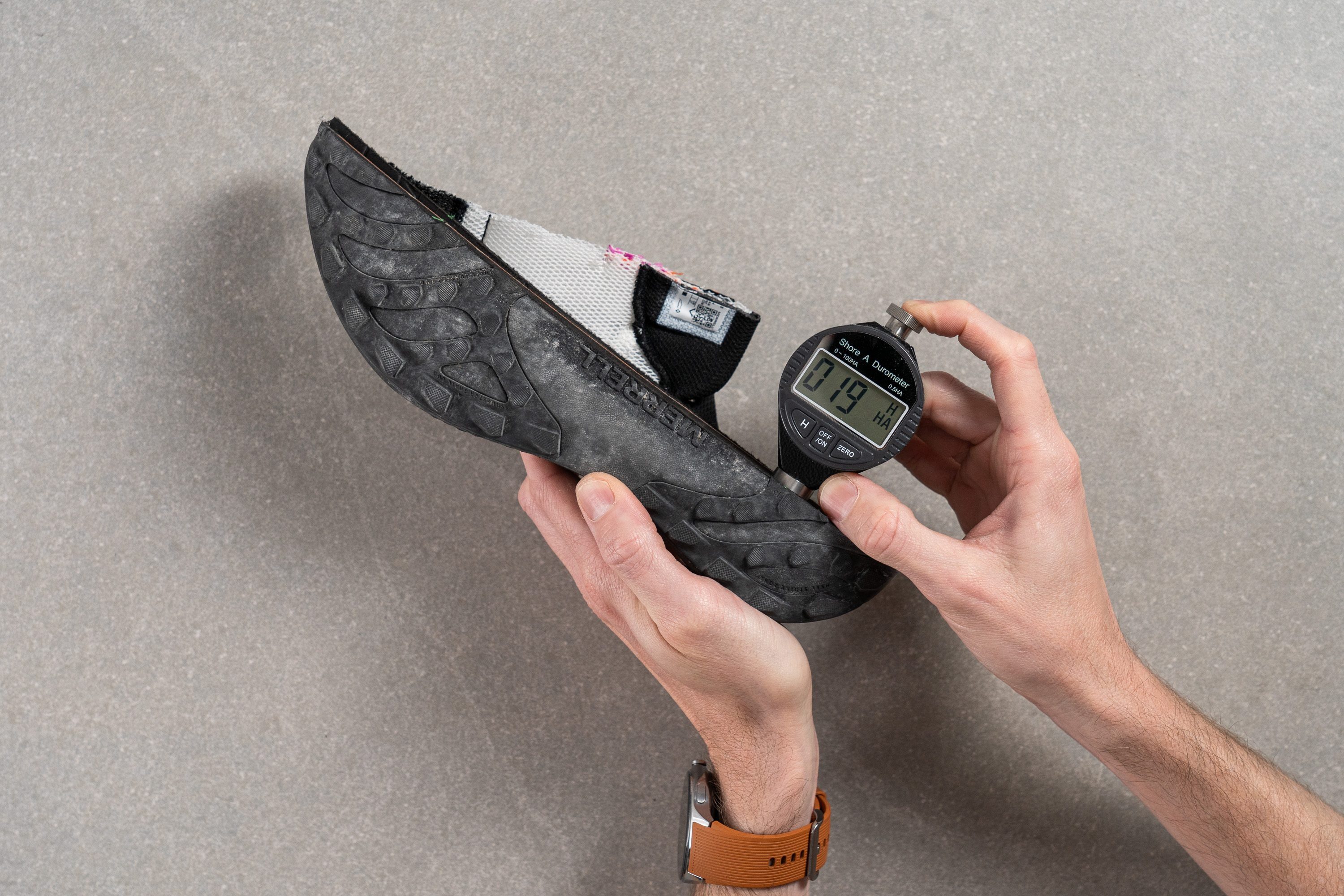
Soft midsoles feel great and are great at absorbing the shock, however, firmer midsoles are often more stable. There’s no “good choice” here, it’s up to your personal preference!
Shock absorption and energy return of men's trail running shoes
While many runners focus on softness, we recommend looking at shock absorption, especially on trails, where you may encounter sharp obstacles or go downhill at high speeds and land harshly over and over again. Shock absorption basically tells us how good the midsole is at absorbing the shock, and the better it is, the less stress is sent towards our joints, tendons, and muscles.
Energy return, on the other hand, is all about responsiveness. Does the midsole recover fast from being squished at the landing? Does it feel bouncy? As with shock absorption, the higher the numbers, the better. The opposite (low energy return) would be running shoes that don't recover well or enough, and that make our legs work more because of that.
Race trail shoes vs. daily trainers
The best thing about running shoes is that, especially if you’re a beginner or a recreational runner, you can find shoes that can do it all. A bit of everything, nothing too extreme. But we should know what those extremes are.
First, trail running shoes for daily runs. Easy miles, recovery runs, and similar. These running shoes are usually quite cushioned and padded as they should make the runs as comfy as possible.
On the other hand, we trail race shoes. Agile, aggressive, often lower to the ground and less padded because cutting the weight is very important.
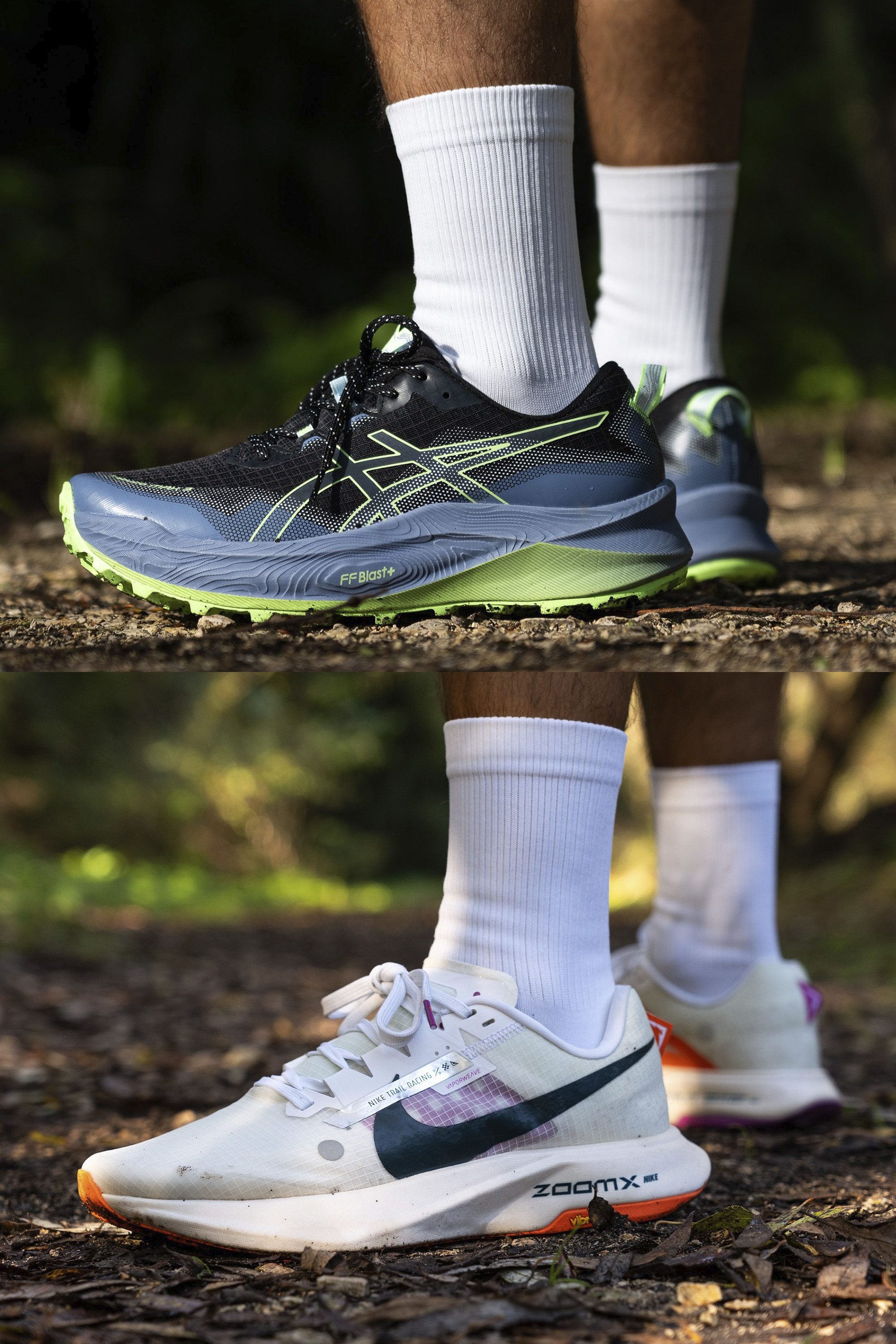
Having a very padded tongue comes in quite handy when you tend to suffer from a lace bite. If you often retighten the laces and experience pain on the instep, best to look for a padded tongue.
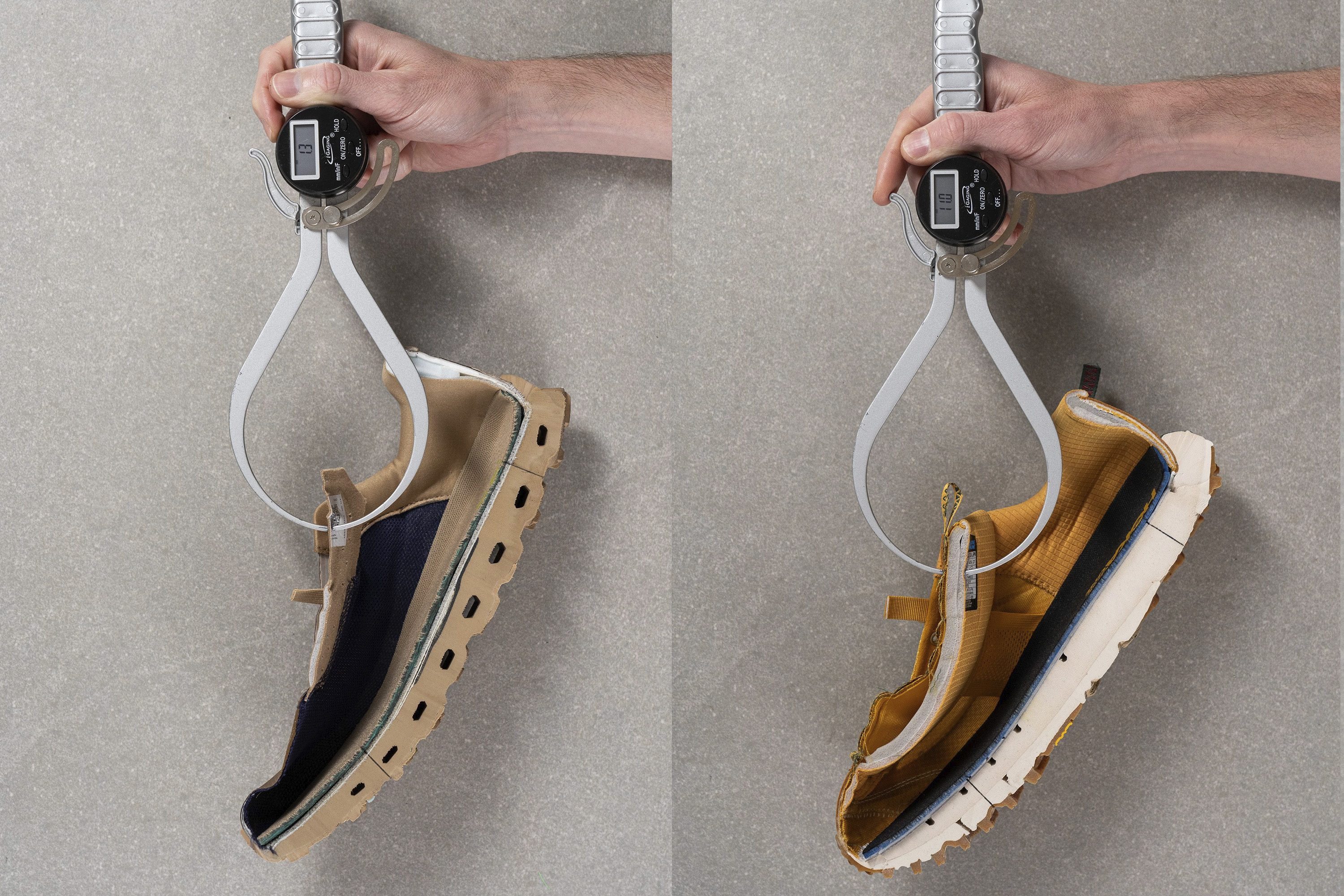
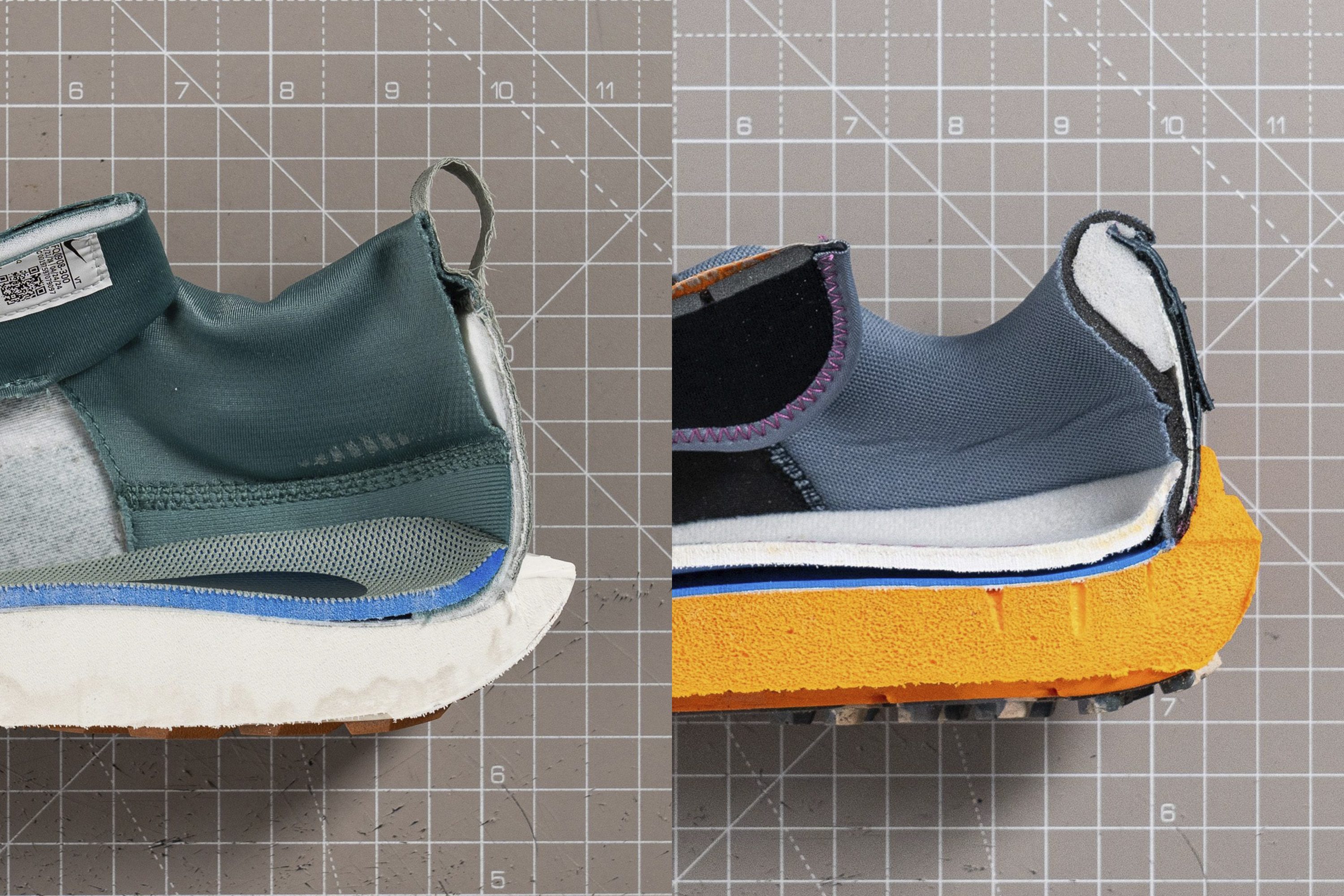
Bonus tip: if you plan to switch the insole or want a very thick/thin one, pay attention to the thickness of the insole and whether it’s removable. We make notes on all of this in our reviews.
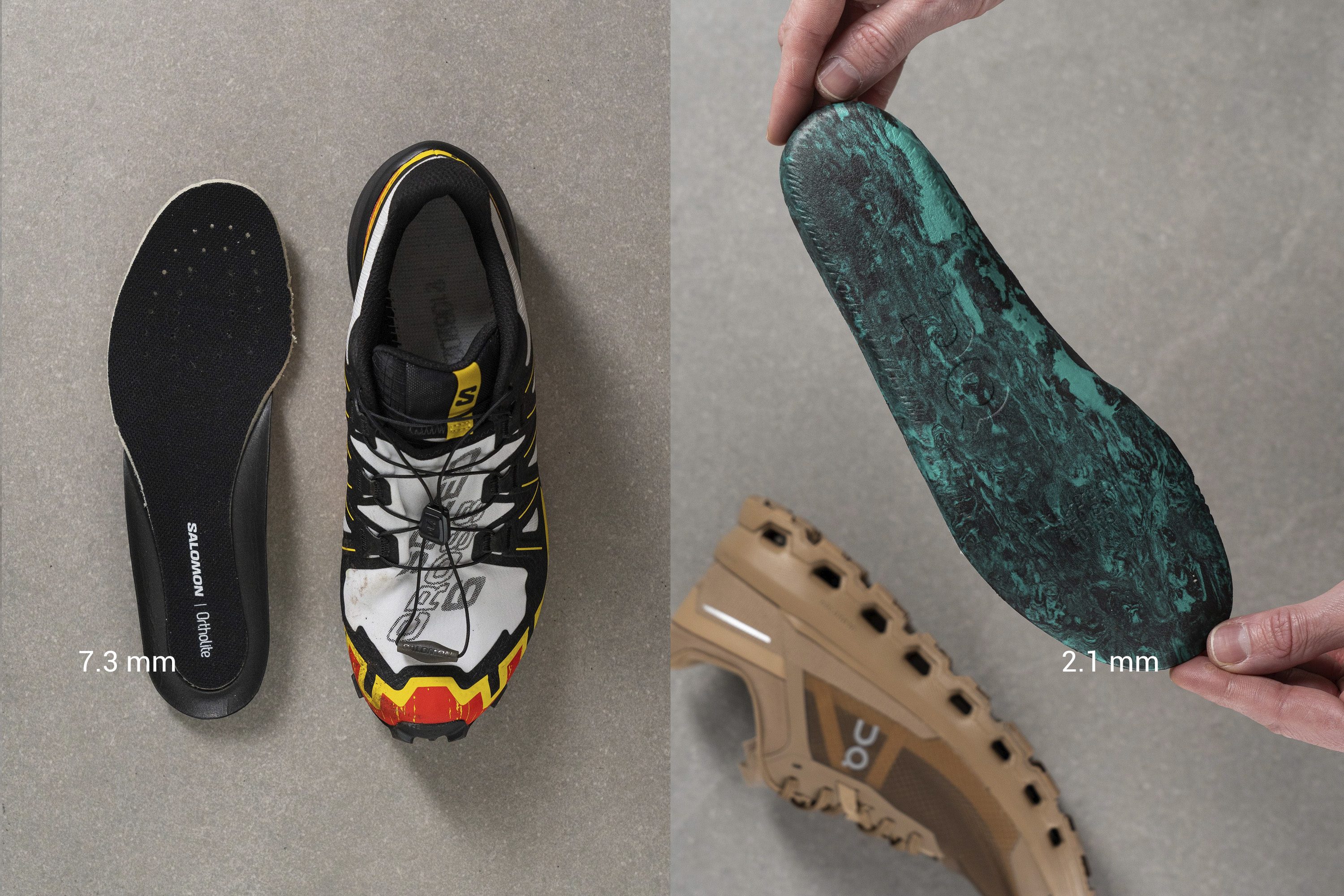
Toebox width and height in trail running shoes for men
While women tend to have wider forefeet than men, it does not mean that a wide toebox is not needed in men’s trail running shoes. Or a very narrow one, for that matter.
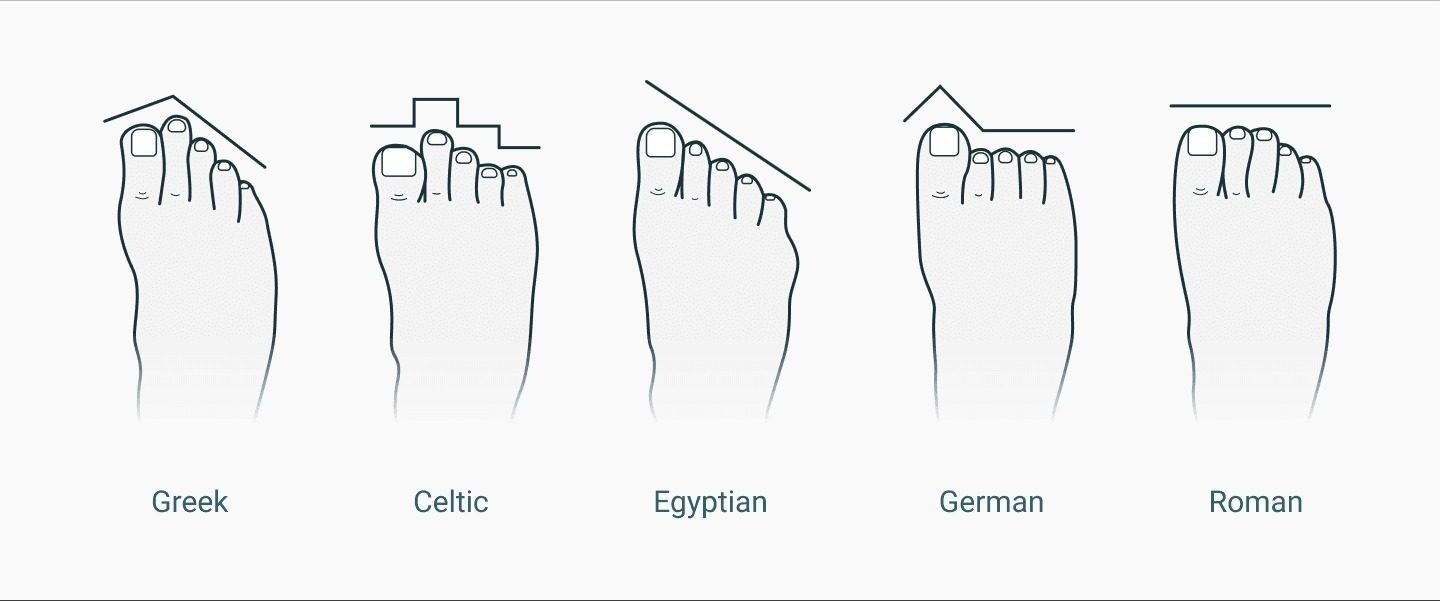
Knowing the width of the shoe where it’s the widest and at the big toe allows us to understand how tapered (pointy) the shoes are and which toe shape they will work for.
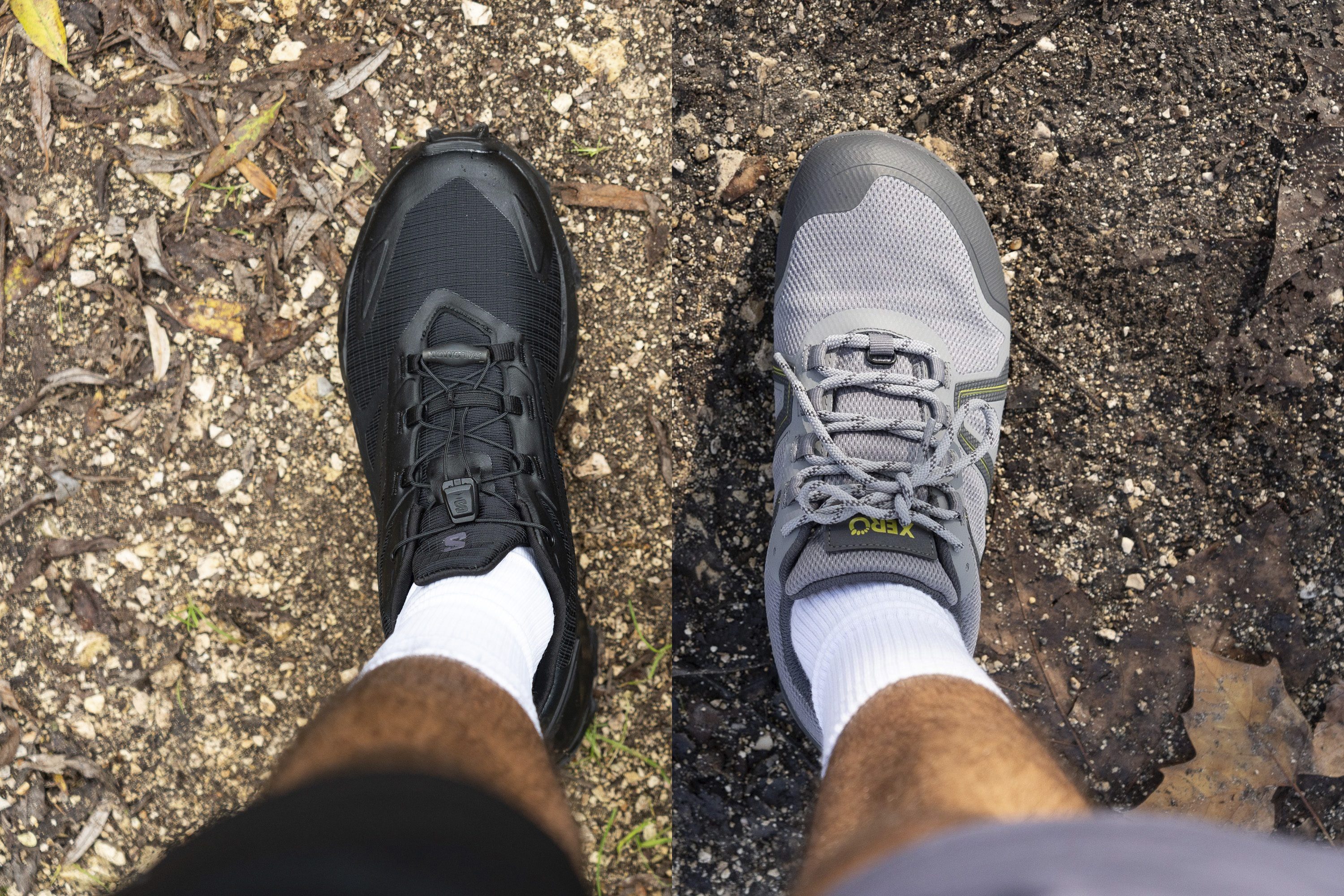
To get these measurements, we fill the shoes with a special gel and then put them in a fridge. This gel perfectly fills the shoes and allows us to make 3 measurements.
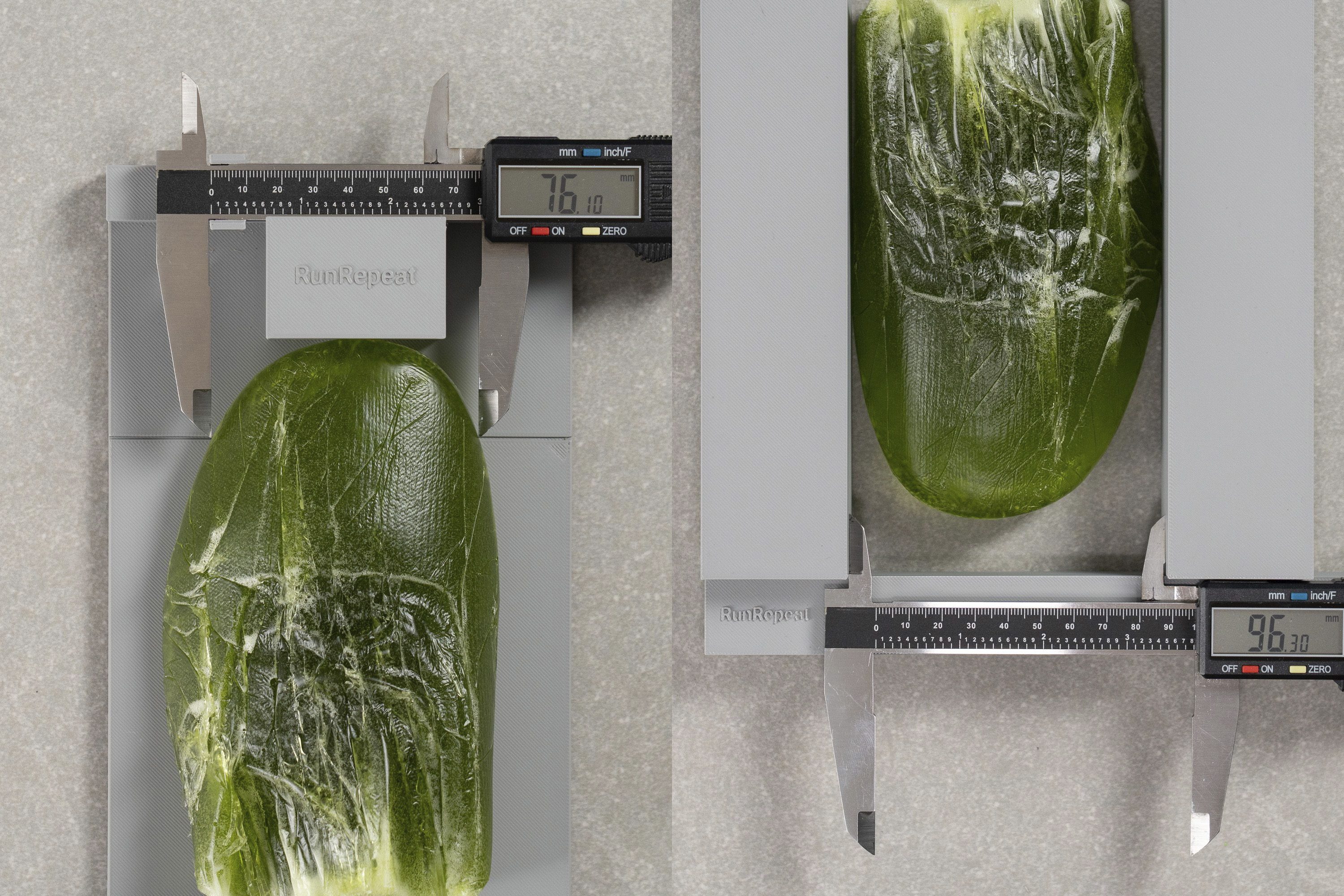
If you need the most room at the big toe, here are men’s trail shoes to take into account:
In case you need more room around the ball of the foot, these trail shoes have the best measurements for you:
And, if you need a narrow shoe, consider these models:
And, as we all know, some men suffer from black toenails. If the toebox presses on your toes from the top, we recommend looking for trail shoes with a high toebox. Again, we use our gels to make the measurement!
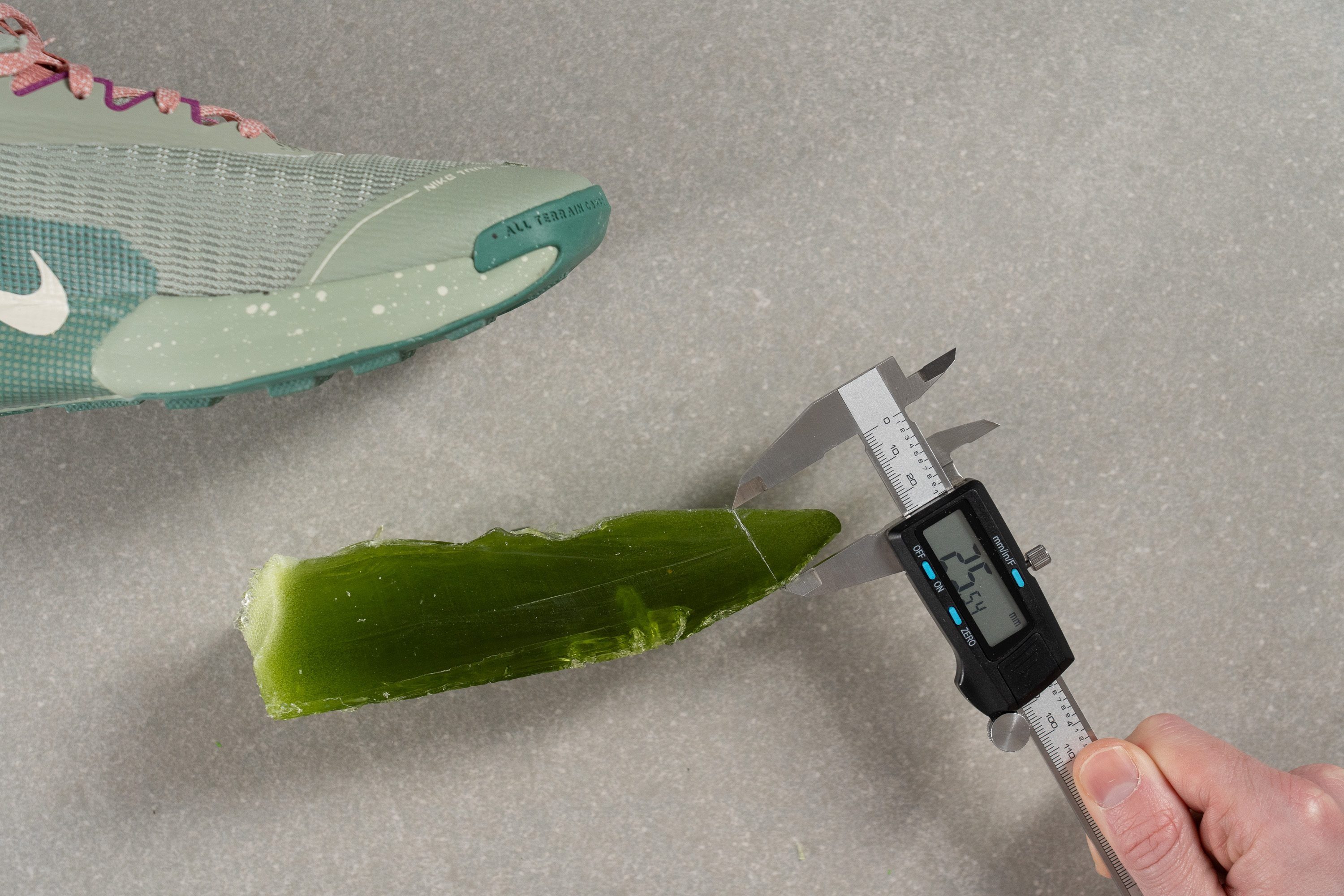
Most durable men’s trail running shoes
Depending on the terrain you’re running and on the overall conditions, you might be prioritising the durability of the toebox (obstacles, hitting the rocks or branches with your toes, sharp objects which could poke through or rip the upper), heel padding (too much friction kills the padding and comfort), or outsole (harsh surfaces). We test all 3 in our lab!
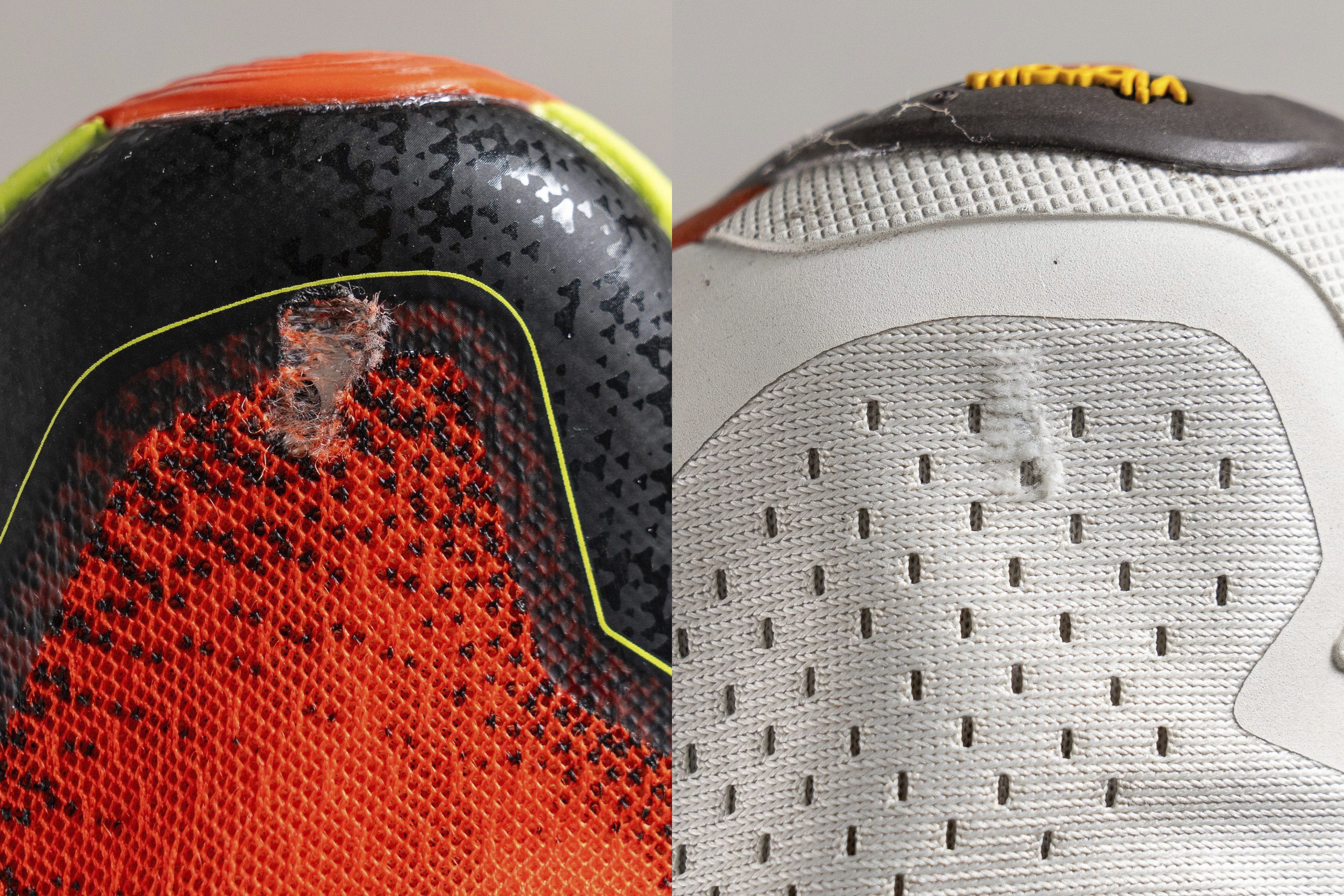
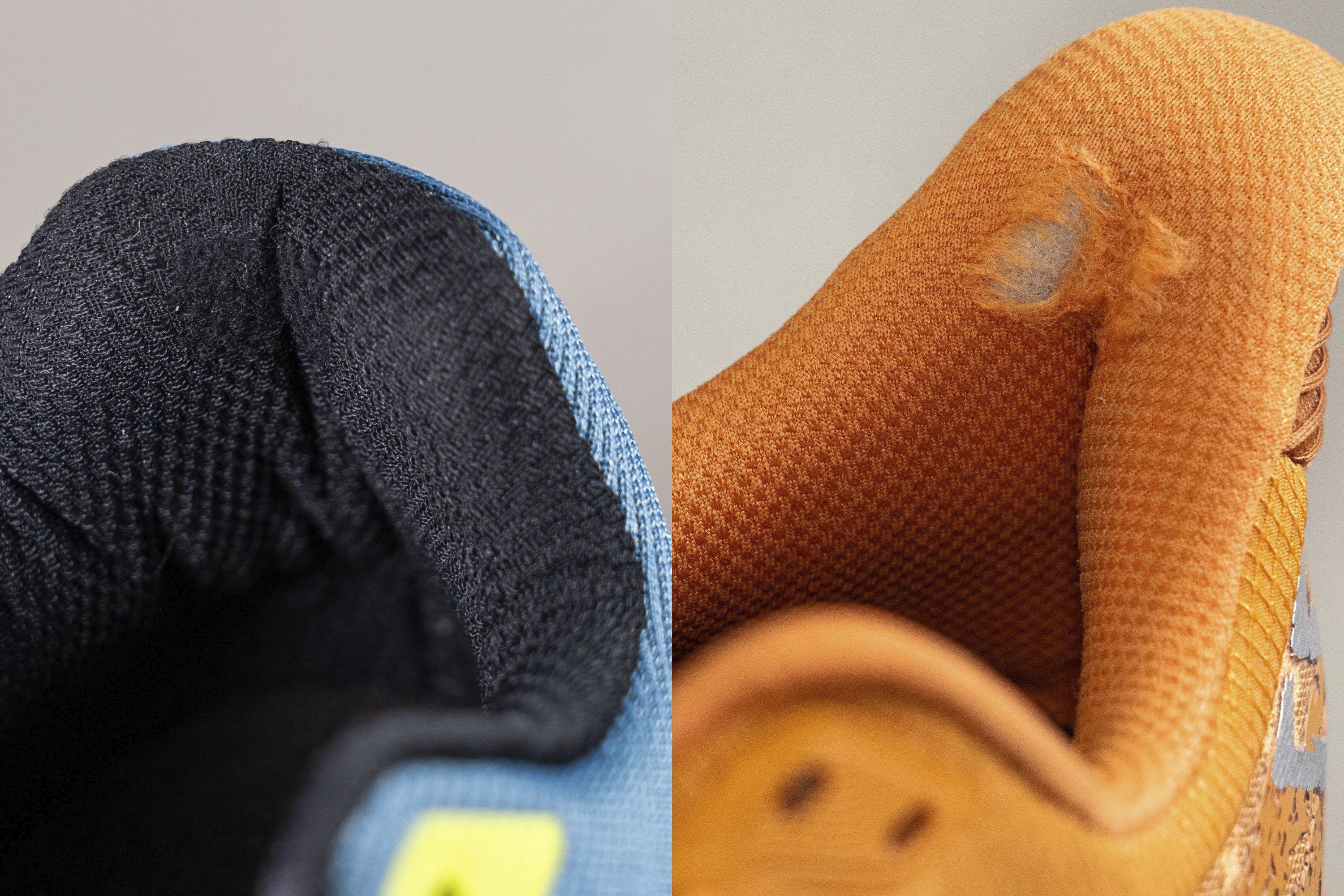
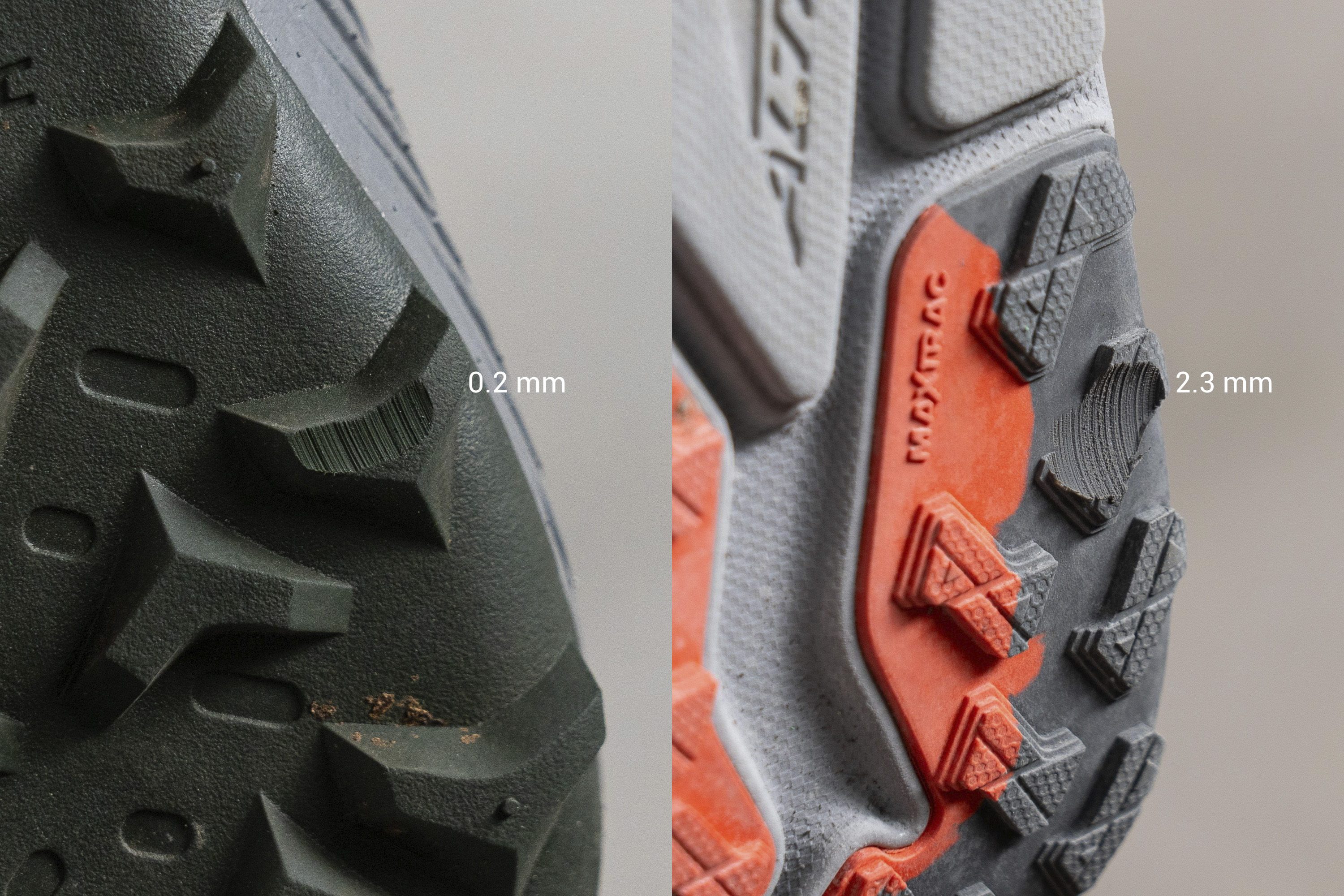
In this case, we don’t have to assess the durability of the outsole because the material is compact. We use a tyre tread gauge to precisely measure the depth of the dent. The deeper the dent, the less durable the outsole!

